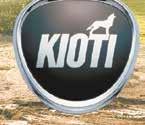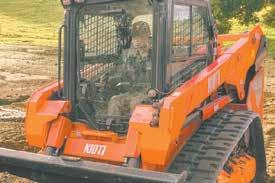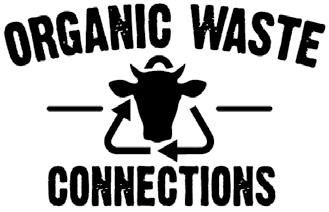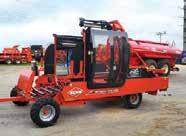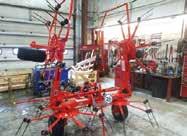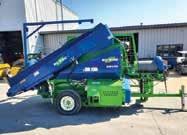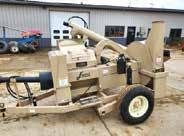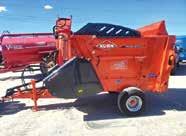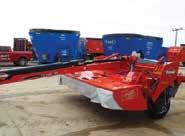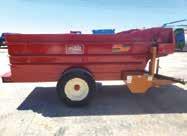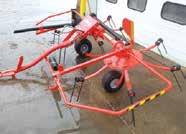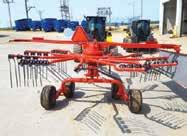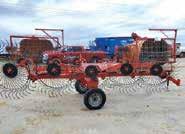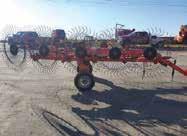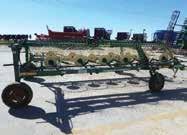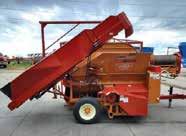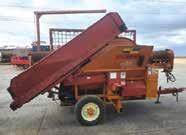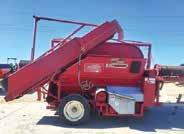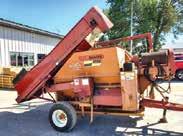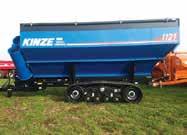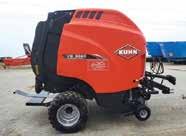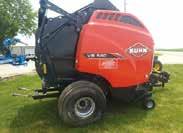




By Amy Kyllo amy.k@star-pub.com
DENNISON, Minn. — Dairy consumption in 2025 is doing well and is also outpacing alternatives in every product group.
“In a lot of the categories, we’ve got record highs,” said Scott Gilray, vice president, business unit operations–north with Midwest Dairy.
There is a lot of consumption of dairy. Cheese is at a new record high, butter is at its highest since 1965, and in yogurt, business is rebuilding.

Gilray said uid dairy milk sales are nine times higher than alternatives, dairy cheese is 174 times higher and dairy yogurt is 61 times higher.
Gilray presented this information and more alongside Shannon Watrin, farmer relations staff member for Midwest Dairy, Feb. 13 in Dennison at one of the Midwest Dairy regional meetings. The pair shared about 2024 checkoff work at the national, regional and local levels.
Locally, Minnesota had 68 Undeniably Dairy grants disburse over $200,000. Undeniably Dairy grants fund up to $5,000 per project for dairy promotion. Some projects include a milk cooler for a weight room, color changing cups for a malt stand and more.
“If there’s something you’re thinking about (doing) ask us,” Watrin said. “We’ll probably nd a way to write an application to fund it.”
In 2024, Undeniably Dairy grants did not fund on-farm events because of the H5N1 bird u. This year, with testing in place, they plan to again fund on-farm events, subject to change.

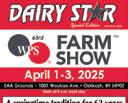
“All
the milk cows can go outside.
Minn. — Matt Rewitzer is living proof that dreams do come true. As of Oct. 1, 2024, Rewitzer is milking cows at his own dairy farm.
“I’ve tried many different ways to get here,” Rewitzer said. “Whenever I did anything, my thought process was, ‘How is this going to get me closer to dairy farming?’ That was always the goal — to dairy farm.”
Last year, Rewitzer purchased a dairy farm complete with 130 cows, a double-6 parlor and freestall barn from Kor Mulder near Bellingham. The farm features headlocks in the freestall barn and the heifer shed and a 10-acre pasture next to the freestall barn so
“I like how efcient this place is,” Rewitzer said. “There are lots of headlocks, so it is easy to catch the cows or heifers for pregnancy checking and breeding. I really like the pasture by the freestall barn. The cows will stay outside until I go get them for milking.”
The farm site is 35 acres and feed is purchased.
“Kor already had agreements with neighbors to get feed so we will continue doing that,” Rewitzer said. “This way I have more time for the cattle and the kids.”
Rewitzer grew up on his parents’ dairy farm near Eagle Bend. However, they sold their herd in 2007. After graduating from Ridgewater
Turn to REWITZERS | Page 5
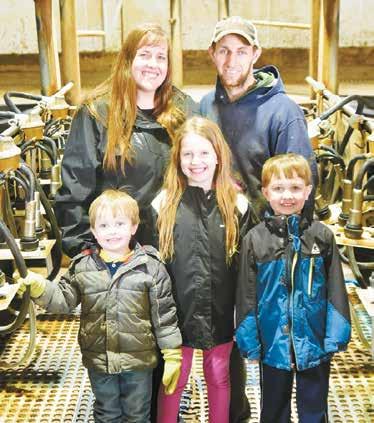
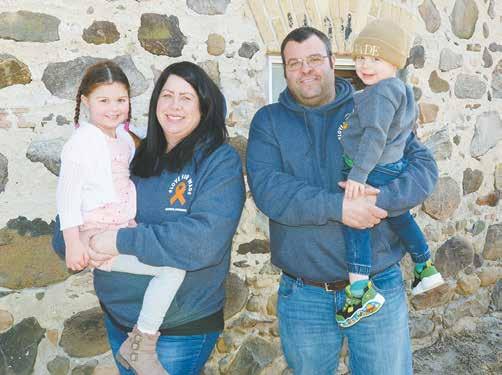
By Stacey Smart stacey.s@dairystar.com
WEST BEND, Wis. — Last fall, Peter and Gina Muth received news no parent ever wants to hear: their son had cancer. Wade Muth was 18 months old when he was diagnosed with acute myeloid leukemia Oct. 21, 2024. AML is a cancer of the bone marrow and blood.
“I was shocked,” Peter said. “It was scary, but it was in God’s hands; it was out of our hands. All you can do is pray about it, and we had a lot of people praying for him.”
The Muths milk 200
and
ISSN Print: 2834-619X • Online: 2834-6203 522 Sinclair Lewis Ave. Sauk Centre, MN 56378 Phone: 320-352-6303 Fax: 320-352-5647 www.dairystar.com
Published by Star Publications LLC
General Manager/Editor
Mark Klaphake - mark.k@dairystar.com
320-352-6303 (ofce) 320-248-3196 (cell) 320-352-0062 (home) Ad Composition - 320-352-6303
Nancy Powell • nancy.p@dairystar.com
Karen Knoblach • karen.k@star-pub.com
Annika Gunderson • annika@star-pub.com
Editorial Staff
Stacey Smart - Assistant Editor 262-442-6666 • stacey.s@dairystar.com
Danielle Nauman - Staff Writer 608-487-1101 • danielle.n@dairystar.com
Dan Wacker - Staff Writer 608-487-3858 • dan.w@dairystar.com
Tiffany Klaphake - Staff Writer 320-352-6303 • tiffany.k@dairystar.com
Amy Kyllo - Staff Writer amy.k@star-pub.com
Emily Breth - Staff Writer emily.b@star-pub.com
Sarah Middendorf - Staff Writer sarah.m@star-pub.com
Advertising Sales
Main Ofce: 320-352-6303 Fax: 320-352-5647
Deadline is 5 p.m. of the Friday the week before publication Sales Manager - Joyce Frericks 320-352-6303 • joyce@saukherald.com
National Sales Manager - Laura Seljan (National Advertising, SE MN) 507-250-2217 • fax: 507-634-4413
laura.s@dairystar.com
Assistant Sales Manager - Kati Schafer (Northeast WI and Upper MI) 920-979-5284 • kati.s@dairystar.com
Adam McClary (SW MN, NW Iowa, SD, Nebraska) 605-864-7917 • adam.m@dairystar.com
Mike Schafer (Central, South Central MN) 320-894-7825 • mike.s@dairystar.com
Hannah Ullom (Western Wisconsin) 715-933-4045 • hannah.u@dairystar.com
Keya Sleister (Eastern IA, Southwest WI, IL) 563-608-5988 • keya.s@dairystar.com
Julia Merten (Southeast MN and Northeast IA) 507-438-7739 • julia.m@star-pub.com
Bob Leukam (Northern MN, East Central MN) 320-260-1248 (cell) bob.l@star-pub.com
Mark Klaphake (Western MN) 320-352-6303 (ofce) • 320-248-3196 (cell)
Deadlines
The deadline for news and advertising in the Dairy Star is 5 p.m. Friday the week before publication.
Subscriptions
One year subscription $42.00, outside the U.S. $200.00. Send check along with mailing address to Dairy Star, 522 Sinclair Lewis Ave., Sauk Centre, MN 56378. Advertising Our ad takers have no authority to bind this newspaper and only publication of an advertisement shall constitute nal acceptance of the advertiser's order.
Letters Letters and articles of opinion are welcomed. Letters must be signed and include address and phone number. We reserve the right to edit lengthy letters. The
by
Peter went back and forth between the farm and Children’s Wisconsin in Milwaukee to help as much as he could while Gina stayed with Wade, who spent 4.5 months in the hospital undergoing four rounds of chemotherapy treatments.
“We still had everything going on here too,” Peter said. “With dairy farming, you can’t turn it on and turn it off. It’s 24 hours a day.”
Peter went down two nights a week to the hospital to give Gina a break, so she could return home to their 4-year-old daughter, Josie.
“We have a great group of employees,” Peter said. “A lot of neighbors stepped up this past fall as well to get eldwork done. They were all a phone call away if we needed an extra set of hands and were more than willing to help. The whole community came together for us.”
In between each round of treatments, Wade was able to come home for approximately one week.
“It was a long road, and the rst month was very rough,” Gina said. “He was in the pediatric intensive care unit and was intubated for a week. He got a cold, and he had a feeding tube for a while until he pulled it out.”
Wade also received three different chemotherapy drugs in his spine.
“Leukemia can hang out in all parts of the body, and a big area that it
The
hides in is the spine,” Peter said.
Cancer did not keep this toddler down, however. Peter said Wade was at that age where he wanted to explore everything and was always on the go.
“During the rst round of treatments, Wade slowed down, but after that, he never slowed down,” Peter said. “He was very active.”
On March 4, Wade returned home cancer-free. Although his cancer is in remission, he has to go back for checkups once a month for the next year to ensure the cancer has not returned and every other month for the second year.
Cancer screening visits will become less frequent the longer Wade remains in remission. Doctor visits drop to every three months during
the third year and every six months during the fourth. Following that, he would return yearly for 10 years. If the cancer were to come out of remission, a bone marrow transplant would be the next course of treatment.
Wade’s journey began last August, when his pediatrician noticed bruising on his chest, which Gina said can be a sign of cancer. A blood panel was run but did not reveal anything abnormal. By September, Gina noticed Wade looked paler, he was clingy, and he was waking up multiple times throughout the night. He had also exhibited signs of Bell’s palsy on one side of his face and had an ear infection that would not heal.
Turn to MUTHS | Page 6









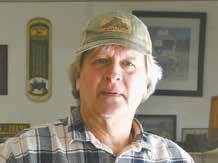




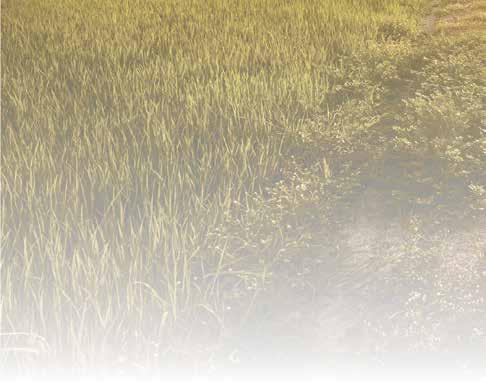
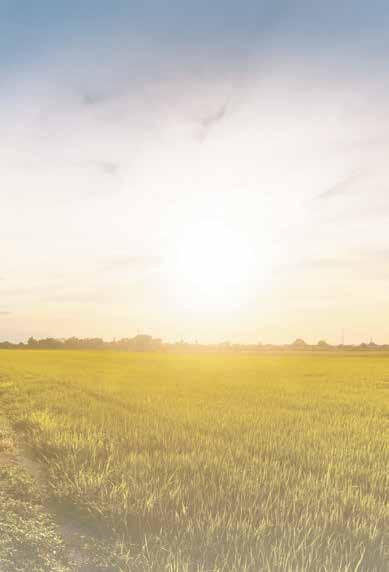
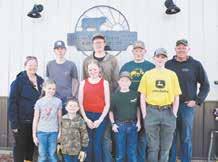
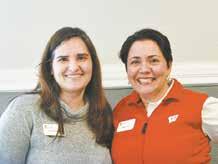
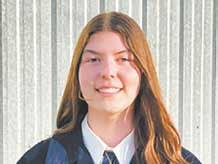
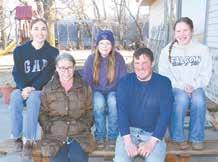
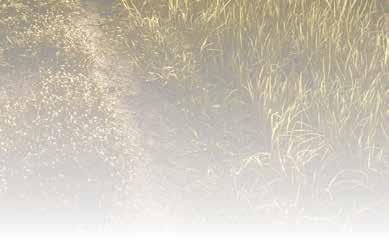













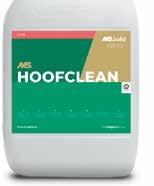
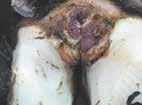
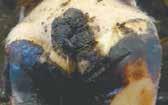

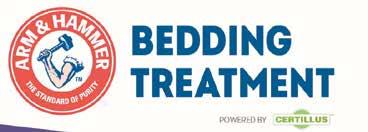
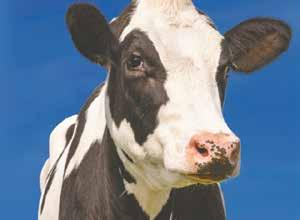



water College, Rewitzer worked for other farmers in the area. He and his wife, Skyla, eventually bought his grandparents’ farm hoping to turn that into a dairy.
“My grandparents’ farm had an old barn, which could have been remodeled to a parlor, but we had a barn re that set us back,” Rewitzer said.
The farm site also had a machine shed that he said had housed all his grandpa’s machinery years ago, but would not come close to housing the machinery he needed.
“We would have to remodel that to even make it work for a heifer shed,” Rewitzer said. “The cost of building keeps going up between concrete, steel, lumber and labor.”
Rewitzer decided he would have to buy a different farm and started looking online while working for other dairy farmers. Most of the farms he found online were either too far away or too big and out of his budget.
After scouring the internet, Rewitzer saw a 130-cow dairy with a parlor for sale by Bellingham, but it had been posted more than 10 years ago. Rewitzer assumed it had been sold after all this time and was never taken off the website.
“Eventually, I called on this farm and sure enough it was still for sale,” Rewitzer said.
Early last year, Rewitzer looked at the farm and immediately liked what he saw. A little while later he came back a second time with his dad and a third time with his wife.
“When I came to look at it with my wife and she saw the house, she agreed,” Rewitzer said. “She knew it was my dream to have my own dairy farm.”
The Rewitzers decided to purchase the farm in the summer. In August, they looked at schools for their kids: Jazlyn, Maverick and Harvey. The school they chose started in August and wanted their kids to start
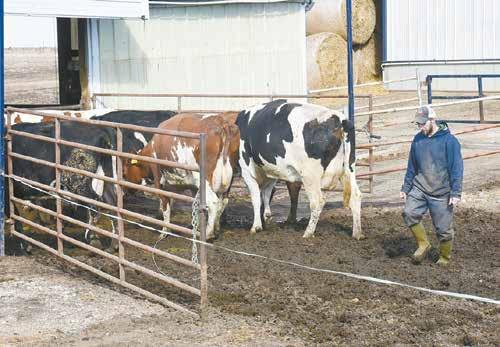
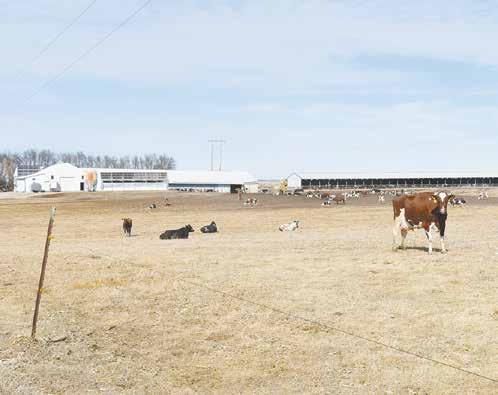
their new school at the beginning of the year so they gured out a way to live on the farm before the sale was nalized.
They borrowed a camper from Rewitzer’s parents so Skyla and the kids could live at the farm while they nalized the paperwork with Mulder and nished the moving process.
“We set (the camper) up the day before school started and Skyla stayed there with the kids while I went back and forth moving stuff,” Rewitzer said. “I came as much as I could, but I was still working.”
Mulder, originally from the Netherlands, immigrated to farm in the U.S. After more than 20 years of trying to obtain permanent residency, Mulder was not able to meet the criteria to stay, so decided to sell his farm.
The Rewitzers, Mulder and their loan ofcer all agreed that on Oct. 1, 2024, the farm would belong to the Rewitzers. For the week leading up to Oct. 1, Rewitzer milked evenings and Mulder milked mornings to make for a smooth transition.
“For me, (the transition) couldn’t have gone any better,” Rewitzer said. “We really appreciate how much Kor helped us out by letting us set up the camper and using his house to get running water. Even after we took over, he would still come by and help us out.”
Rewitzer said it feels good to have accomplished his dream.
“I like all of it, being with the cattle, mixing feed, breeding the cows, raising up the calves and seeing my kids out here with me,” Rewitzer said.
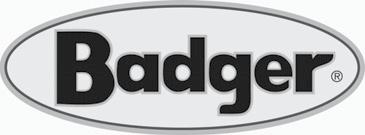
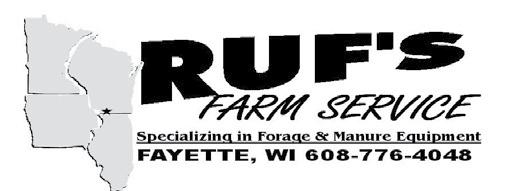
Tell the advertisers you saw their ad in the Dairy Star!




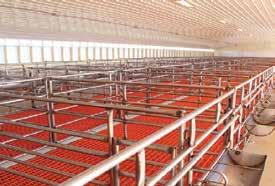





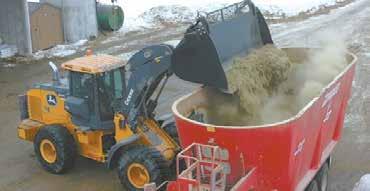















Wade Muth drives a car down the hallway March 4 as he is released from Children’s Wisconsin in Milwaukee, Wisconsin. Wade was diagnosed with acute myeloid leukemia Oct. 21, 2024, at 18 months of age and is now in remission a er having four rounds of chemotherapy treatments.
“Wade went more downhill after that,” Gina said. “He had a respiratory infection and colds that didn’t go away. His symptoms lingered on. When we thought he was nally getting better, a whole new dose of something else would start. It took three medications to nally clear his ear infection. He would also puke randomly and was very pale. He was not himself.”
At an urgent care visit in Mequon, the doctor noticed Wade had an enlarged spleen. Wade’s 18-month appointment was moved up, and another blood panel was run. This time, the results were troublesome.
The Muths were already on their way to Children’s Wisconsin to check on Wade’s Bell’s palsy when their pediatrician called, and they were instructed to go to the emergency room. Another panel was run, and Wade was admitted to the hospital that night.
of distress they experienced kindness from many directions.
“The generosity from friends, family, and complete strangers was overwhelming,” Peter said. “It still is.”
The Muths said they are happy to be on the other side of this ght.
“We’re cautiously optimistic,” Peter said. “We’re really excited to be here, but it’s always in the back of your mind now — what if? Doctors told us if the cancer comes out of remission, more than likely it will be in the rst year. After the rst year, odds of it coming back drop greatly.”
The Muths’ neighbors are hosting a benet for Wade March 29 starting at 1 p.m. at Fillmore Turner Hall in Fredonia. The event, which was spearheaded by the farm community, will feature a tractor ride, food, drinks, rafes, a silent auction, kids’ activities and live music.





“Prior to this, I had said to Peter, ‘What if Wade has cancer?’” Gina said.
Her fears were conrmed that October day as the family entered what would be an intense battle to save their son’s life. Wade was immediately given blood and platelets, and his color came back.
Wade’s leukemia was caused when chromosome 16 ip-opped with another chromosome.
“What he has is very rare,” Peter said. “He has low-risk AML, and there are not many cases each year of this type of leukemia. AML is more prevalent in adults than children, but low-risk AML has a higher probability of being cured.”
Doctors told the Muths Wade’s age and sex were helpful factors in his recovery.
The Muths said during this time
The Muths said they have received tremendous love and support from their community.
“We’re really thankful for what they’re doing for us,” Peter said. “I’m on the Fillmore volunteer re department, and my re department family has done a lot too. The whole community has been amazing.”
Gina’s sisters and cousins also put on a benet for the Muths in Gina’s hometown.
Wade is a busy toddler who enjoys playing with tractors and other farm toys. On April 4, he will celebrate his second birthday.
“We’re grateful we’re home and grateful for this outcome,” Peter said. “Wade is in a really good place now, and hopefully the cancer stays in remission. If it comes back, we know what we have to do. But the outlook is very promising.”
In 2024 Midwest Dairy was working on science-focused education, including a seminar and webinar at the Minnesota Science Teachers Association conference.
“We’re giving them opportunities to hear … how does dairy work within the sciences, what kind of technology is working within the dairy,” Gilray said. “As they’re talking to their students … (they’ve) got a very positive view of dairy and how we do things.”
Through MSTA, Midwest Dairy shared a science agriculture curriculum that meets state and national standards.
As a parent, Watrin said she is excited about this collaboration.
“We’re (not) feeding them an agenda,” she said. “We’re empowering the teachers to teach the students how to think on their own.”
She said learning about food is interesting to students because of its universal common-ground factor.
“They want to know what they’re eating is good,” she said. “They want to know that the dairy farmers … that are making their food are doing good things for the environment.”
Gilray agreed, and said increasingly people, especially in the younger generation, view food as medicine.
Another science education focused initiative in 2024
was a panel Midwest Dairy was part of with an AI climate change team for a lunch and learn at the University of Minnesota.
On the panel, several dairy farmers shared about the dairy industry and its sustainability efforts. Gilray said the panel was well received by the leader of the AI climate group.
“(He basically said) ‘This was amazing, we learned more in this 1- or 2-hour session than we’ve learned in the last six months,’” Gilray said. “(He said,) ‘We have to have more of these conversations.’”
dairy markets. The projects are from six universities supported by 16 professors.

Shannon Watrin
Midwest Dairy’s investment in increasing dairy sales at the retail level had multiple activations in the Midwest. These activations helped grow incremental milk sales, which represent sales above and beyond the baseline of what would have been sold without the extra promotion.
Gilray said these partnerships only occur with organizations that are like minded.
Midwest Dairy was also involved with a conference for the Upper Midwest Association for Campus Sustainability. There, they shared a fact versus ction panel session on sustainable farming practices and other topics for over 300 students representing 49 universities.
“We have very open and honest conversations,” Gilray said. “That’s how we get our … information out to these college kids so they start understanding the truths about what … dairy farmers do.”
In research, the Midwest Dairy Foods Research Center helped fund six research projects that benet consumers and help create strong
“We want to work with those organizations that want to partner with farmers,” he said. “We don’t want to come in and bring our dollars and talk about the goodness of dairy and then the very next week, they’re advertising an alternative beverage. … We want somebody that really partners with us.”
Midwest Dairy worked with Kwik Trip to help promote three of their limited time ice cream avors. The campaign resulted in over 578,000 pounds of incremental milk.
Midwest Dairy helped Pizza Ranch develop and promote loaded cheesy ranch stix as well as helping promote a value meal deal. The campaigns resulted in over
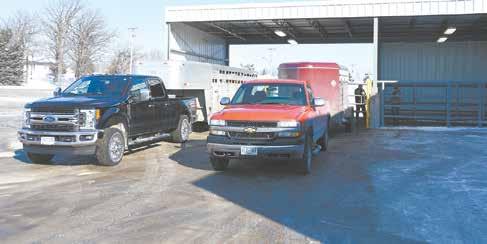
900,000 pounds of incremental milk.
Coborn’s Inc. grocery store did four campaigns with Midwest Dairy. This included videos of Princess Kay of the Milky Way and Kerfeld Hillview Farm going on their website as well as an appearance on TV, a back-to-school cooking class, and more. The promotions resulted in over 620,000 pounds of incremental milk.
Midwest Dairy also collaborated with Freddy’s Frozen Custard & Steakburgers to develop and promote three menu items: a grilled cheese steakburger, a pumpkin pie concrete shake and a caramel apple pie concrete shake. The activations resulted in 5.8 million pounds of incremental milk.
Midwest Dairy also collaborated with thought leaders, working to connect to consumers through them.
“We explain to them about how good dairy is, the benets of dairy, from the nutritional value, to recipes, to sustainability,” Gilray said. “Then, they go and they talk to their consumers.”
This work with thought leaders included 39 TikTok videos aimed at GenerationZ consumers. The videos resulted in 5.26 million impressions and follow-up surveys showed an 11% increase in trust in the dairy industry’s animal care.
Online, Midwest Dairy utilized banner ads, dairy recipes ads with a “shop recipe” quick link button and more to encourage dairy sales. This initiative worked to capitalize on the fact that 60% of shoppers purchase their groceries online.
On the international scene, Dairy Management Inc. continued to encourage dairy exports, which account for 17% of the U.S. milk production.
“Exports are increasing as global demands of protein are increasing,” Watrin said. “We have a lot of developing countries that are looking to dairy to be an inexpensive, very effective source of protein for their growing nations.”
DMI has eight retail chain partnerships in ve countries and culinary partnerships in seven countries. One collaboration has been to get 30% more cheese on pizzas at Pizza Hut in Japan.
Recently, DMI collaborated to help General Mills develop a new, snackable, crispy yogurt-based product called YoBark.
Watrin said General Mills is looking to collaborate beyond product development as well.
“They’re very interested in the farmer story and how they can share that through their products and branding,” she said.





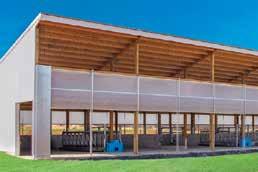


By Amy Kyllo amy.k@star-pub.com
OWATONNA, Minn. —
Ninety-six square feet of table-top real estate holds about two-thirds of Scott Krause’s butter box collection. The 8by 12- foot table space holds about 980 boxes.
And yes, these are butter boxes, the small, branded cardboard containers which hold four sticks of buttery deliciousness.
“It’s an addiction,” Krause said. “If I drank beer as much as I collect butter boxes, I’d be alcoholic.”
Though he has never counted his full collection, Krause believes it numbers around 1,500 boxes, of which about 1,000 are unique.
“It’s a rush when you nd one that you don’t have,” Krause said.
Krause and his dad, Loren, milked around 100-120 cows until 2021. Now, Krause raises beef and dairy animals.
His butter box collection spans about 100 years of butter boxes. His earliest boxes are from the 1920s, he said, and a few familiar boxes from the current decade also grace
his collection. Most boxes are from the 1950s and 1960s.
“That was a time when a lot of those creameries (were) a center point of most little communities,” Krause said.
Krause’s collection has boxes representing creameries largely from Minnesota, Wisconsin, Iowa, South Dakota and North Dakota and a few from Michigan, Pennsylvania, Nebraska and Wyoming. Many of his boxes are from creameries that once existed in southeast Minnesota.
“I like to get the ones that are more local,” Krause said. “It’s always fun just nding one that you never had or found.”
Several of his favorite butter boxes include Moose Lake Special Creamery, Lakeland Creamery and Mountain Lake Creamery, each of which has an outdoor scene with a lake depicted on the front of the box. Another favorite box is the Ewald Bros. butter box. This box features a Guernsey cow on the front. The Krause’s milked predominantly Guernseys until the 1980s when they began switching to Holsteins and some Jerseys.

Krause’s collection is not displayed yet. He hopes to eventually get the boxes un-
der glass in alphabetical order by county. Krause nds the butter
boxes at antique stores, swap meets, online auctions, Facebook Marketplace and more. Everywhere he goes he gives out his number to vendors, asking them to call him if they get a box.
“Every couple of months you nd a different one,” Krause said. “Sometimes, you go for a long time and do not nd any, but I’m always on the lookout.”
If he has time on the weekends, he goes hunting at antique stores.
“It’s fun to do,” Krause said. “When I go somewhere, I just get excited, like, am I going to nd one or not?”
Local towns’ history centers can also be helpful when it comes to knowing what creameries existed, Krause said. Krause also watches for old creamery buildings in the countryside when he and his dad go for drives.
While prices vary, Krause said the most he has ever spent on a box in his collection is about $70.
“I like to go to the swap meets because those guys you can work with,” Krause said. “If they want to get rid of it … you can give them an offer and they’ll usually take it.”
APRIL 1 THROUGH APRIL 30 AT

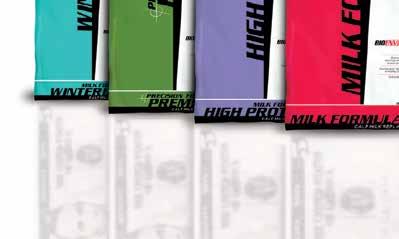



Krause said once he got caught up in an online auction bidding on boxes and the price went to $600. He decided he had to quit and did not get the boxes. A few months later, he found the same box designs for less.
If a box is selling cheaply, he will buy a duplicate that he can trade or sell with someone else if he wants to.
Krause said he has only been scammed once, and that was on Facebook Marketplace.
“They got my money and I didn’t get the boxes,” Krause said. “There’s a crook in every business, even butter boxes.”
Krause started collecting about 20 years ago. He was rst introduced to the hobby by a dairy eld representative who came to the farm. Krause said the eld representative would show him whenever he found a butter box.
“I never dreamed back in those days I’d be doing this,” Krause said.
Krause knows a few other people who collect butter boxes. He is part of a group with a Facebook page dedicated to butter box collecting. He said his parents’ generation had a different mentality when it came to saving things.
“Everyone else thinks it’s junk and they throw it out,”
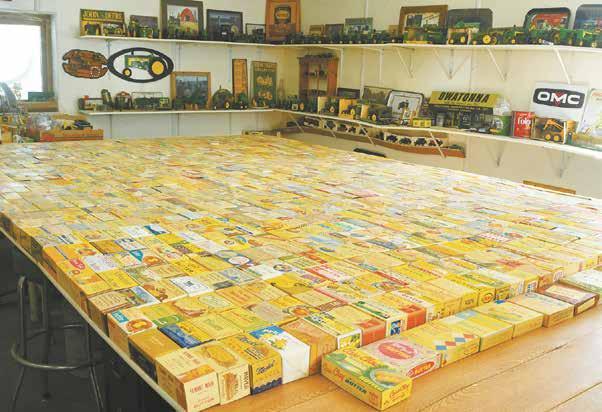
Krause said. “There’s probably a lot of butter boxes that were in someone’s attic that just got tossed.”
Besides butter boxes, Krause has a small collection of cardboard containers from other dairy products. He also collects John Deere farm toys and has a collection of about 1,500 beer cans.
“It’s always fun, just the challenge to nd another one,” he said.
Looking to the future,

Krause hopes to collect for as long as he can.
“Maybe I’m too old fashioned, but … I like doing it,” he said.
Eventually, he said he is thinking about donating the collection to the Minnesota State Fair for permanent display. He would like to have them in the dairy building near the Princess Kay of the Milky Way butter sculpting booth.
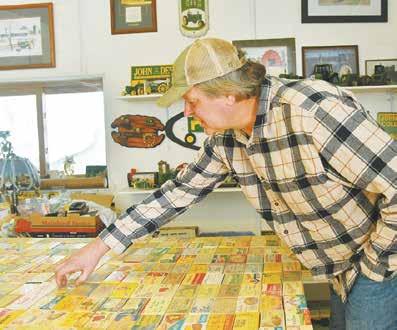

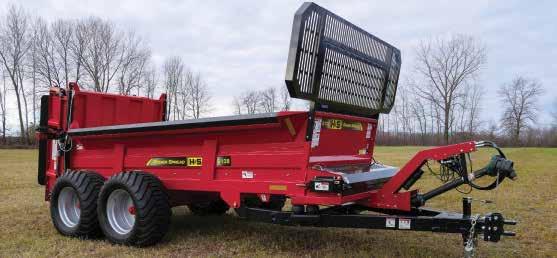


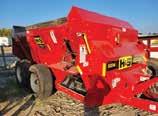
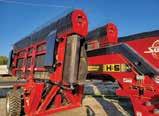
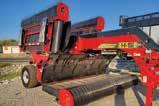
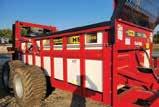


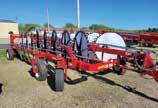





“The pregnancy report is very useful.”
What are some of the DHIA tests you use?
Other than the standard reports, we also receive pregnancy results.
Which is your favorite and why? The pregnancy report is very useful to keep our calving interval where we would like it.
How do you use them within your dairy? We use the production and SCC reports for culling decisions and use the fat, protein, and MUN reports to evaluate feed ration changes.
How long have you been using the DHIA pregnancy test? We have been using the milk pregnancy test for about two years.
What do you like about the DHIA Pregnancy Tests? It’s nice to be able to do the pregnancy test without any extra time or labor.
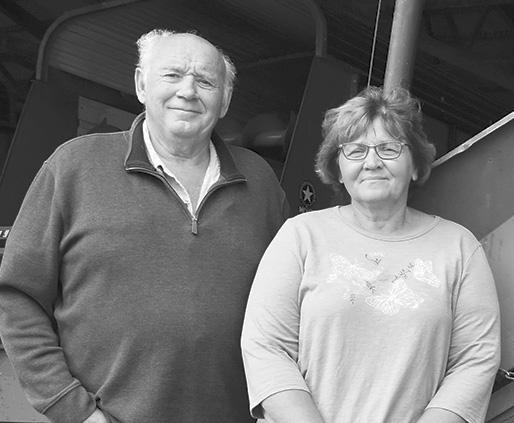
How does testing with DHIA bene t your dairy operation? We also use the individual somatic cell count scores. This helps us keep our SCC low so that we can receive quality premiums from our co-op.
Tell us about your farm. We milk 95 cows and raise all of our replacements. The cows are housed in sand bedded freestalls and milked in a double 5 parlor. We also have a 40-cow beef herd and raise chickens for Pilgrims Pride. Our farm was started by my father and grandfather in 1937. Two of our children and most of the grandkids work on the farm.

On March 6, President Trump announced a 30-day pause on all tariffs to Canada and Mexico. A day later, Trump made another change in the tariff policy. “Canada has been ripping us off for years on lumber and dairy products; 250% (tariff on dairy products), nobody ever talks about that, which is taking advantage of our farmers.” Trump promised to retaliate with new tariffs coming in a matter of days.
International Dairy Foods Association response
The International Dairy Foods Association released a statement in response to President Trump’s criticism of Canadian dairy tariffs. “It is accurate that Canada imposes a tariff of approximately 250% on U.S. exports of certain dairy products from Canada, and even more with Canada’s 25% retaliatory tariffs in place,” said Becky Rasdall Vargas, senior vice president, IDFA. However, that tariff would only apply if U.S. dairy exports exceed the parameters of the U.S.-Mexico-Canada Agreement. Due to protectionist policies in Canada, the U.S. has not gotten close to those quota levels. Rasdall Vargas said the U.S. dairy industry appreciates the Trump administration’s efforts. “At the same time, a prolonged tariff war with our top trading partners will continue to create uncertainly and additional costs for American dairy farmers, processors, and our rural communities. We urge Canada and the United States to negotiate a resolution to these issues.”
The letter was sent by Minnesota Sen. Amy Klobuchar, Wisconsin Sen. Tammy Baldwin, Kansas Sen. Roger Marshall and Iowa Sen. Joni Ernst
Policy experts seek better safety net for farmers

By Don Wick Columnist
At the National Farmers Union Convention, agricultural policy leaders addressed key farm policy challenges, including legislative uncertainty in Washington. “I think right now, the easiest way to describe Capitol Hill is a bit chaotic,” said Brad Weddelman, majority chief economist, Senate Agriculture Committee. “There’s a lot going on with a new administration, new chairman.” Despite the turbulence, Weddelman stressed that Chairman John Boozman remains focused on passing a 5-year farm bill with a stronger safety net. “He’s preached that over and over again. That is his goal for this year,” he said. The conversation also centered on improving disaster assistance programs for farmers. Harlea Hoelscher, a professional staffer for the House Ag Committee, outlined House farm bill provisions aimed at strengthening relief efforts. “Chairman (Glenn ‘GT’) Thompson followed the principle of how we can bolster the programs that we already have and make them work better for producers.”
Waters of the U.S. guidance updated
Lawmakers seek fairness in trade
A bipartisan group of senators is calling for fairness for dairy farmers in any trade talks with Canada. The lawmakers sent a letter to the agriculture secretary, commerce secretary and U.S. trade representative, saying Canada has hurt U.S. dairy prices by selling dairy products worldwide at articially low prices. The letter said, “Historically, Canada has failed to live up to its commitments to provide access to its market.” The lawmakers also contend Canada appears to be evading USMCA rules and is exporting protein at articially low prices.
The Waters of the United States rule is getting another revision. Environmental Protection Agency Administrator Lee Zeldin said this change will stand the test of time. “We are not looking for this to be ping pong anymore; what we’re looking for is to simply follow the guidance from Sackett (Supreme Court ruling),” Zeldin said. “It gave us a clear path in determining the waters of the United States. It found only those wetlands with a ‘continuous surface connection to a relatively permanent water’ are Waters of the United States. The court also struck down the long-utilized signicant nexus test, leaving only
those wetlands that abut or are adjacent to waters of the United States as jurisdictional.” Zeldin said his agency will work with the U.S. Army Corps of Engineers to cut permitting costs and reduce red tape. American Farm Bureau Federation President Zippy Duvall was part of the announcement and said WOTUS has been a pain in the side for farmers; “This is a rst big step in a very difcult farm economy that gives farmers and ranchers hope, hope that good things are going to happen in the future.”
Make America Healthy Again Commission meets
The Trump Administration’s Make America Healthy Again Commission met for the rst time. Health and Human Services Secretary Robert F. Kennedy Jr. and Agriculture
Secretary Brooke Rollins said they are committed to a holistic process to improve the federal dietary guidelines. Rollins said these guidelines will be based on sound science and released ahead of its Dec. 31 deadline.
Testing underway in Minnesota dairy herds
Minnesota is in the third week of testing its dairy herds for highly pathogenic avian inuenza. “We’ve tested over 400 farms and had no positive cases,” reports Agriculture Commissioner Thom Petersen. “We also haven’t had a positive case in poultry for a couple of weeks.” Petersen said another week of testing is needed before the next phase can begin. “We’re optimistic that will happen; we’re continuing to urge farmers to follow biosecurity measures and to keep their guard up.”
Bill introduced to support processing
State Senator Andrew Lang of Olivia has introduced a bill to appropriate funding to support Minnesota’s milk and meat processing sectors. “By investing in our processing facilities, we not only support our local farmers and producers but also ensure that Minnesotans have access to highquality, locally produced food products,” Lang said.
March supply and demand estimates released
According to the U.S. Department of Agriculture’s latest supply and demand report, 2025 milk production estimates were lowered to 226.2 billion pounds. Lower-than-expected milk output per cow was cited as the reason. The Class III price forecast was lowered with a drop expected in cheese and whey values in the year ahead.
Export assistance program gets a name change
The National Milk Producers Federation board of directors has voted to change the name of its voluntary dairy export assistance program. Cooperatives Working Together was created in 2003 with dairy co-ops and individual producers contributing to this program. The new name of this program will be NEXT, which stands for NMPF Exports and Trade. A new business plan for the successor organization will be up for nal approval in June.
Danish dairy co-op to partner with South Dakota rm
Arla Foods plans to produce whey protein for the food and beverage industry through a partnership with Milbank, South Dakota-based Valley Queen. Arla Foods is one of the largest dairy cooperatives worldwide and is based in Denmark.
Trivia challenge
Texas is the home state for Agriculture Secretary Brooke Rollins That answers our last trivia question. For this week’s trivia, what country consumes the most cheese on a percapita basis? We’ll have the answer in our next edition of the Dairy Star.
Don Wick is owner/broadcaster for the Red River Farm Network of Grand Forks, North Dakota. Wick has been recognized as the National Farm Broadcaster of the Year and served as president of the National Association of Farm Broadcasting. Don and his wife, Kolleen, have two sons, Tony and Sam, and ve grandchildren, Aiden, Piper, Adrienne, Aurora and Sterling.
We are sourcing
nd those hard to nd items including:
• Electric motors
• Fan parts (blades, bearings, belts and pulleys)
• Gearboxes
• Submersible pumps
• PPE - hoof trimming and maintenance
• Camlock fittings
• Hose & Tubing
• Push to connect fittings
• Air compressors
• Waterer parts
• Parlor items

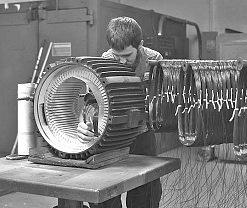




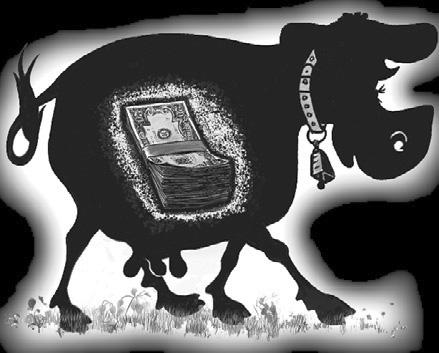
Scan the QR codes to find our pages or follow us @dairy_star_newspaper

USED TRACTORS






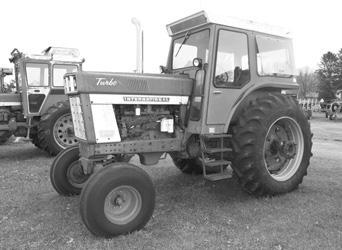
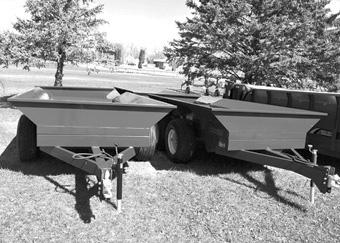
Midsota wagons ON HAND!
CIH 8910, 1955 hrs., 2WD, like new$105,000
CIH 7120, 2WD, 5800 hrs. ................$55,000
CIH 7120, 2WD, 4,900 hrs. ...............$55,000
CIH 7120, 2WD, 6,100 hrs. ............Coming In
CIH 7110, 2WD, 4500 hrs..................$63,000
CIH 5250 2WD, 4,700 hrs. .............. $54,000
CIH MX120, 2WD, 3,800 hrs. ............$72,000
CIH MX120 w/loader ........................$75,000
CIH MX100, 2WD, open station w/ldr.Coming In
IH 1456, ........................................... $22,000
IH 1466, 6800 one-owner hrs ............$21,000
IH 1086, 7,500 hrs. .........................Coming In
IH 686 . ..............................................$14,000
‘98 JD 7610, 19 spd., PS, 5,500 hrs., 25 MPH, very sharp ....................... $75,000 McCormick MC120 FWA, 2,600 hrs ..$57,000
TILLAGE
CIH Tigermate II, 26’..........................$28,000
CIH Tigermate II 26’ w/rolling basket $32,000
CIH Tigermate 200 w/basket, 34’ ..... $42,500
CIH Tigermate 200, 28’ w/rolling basket ...............................$40,000
CIH Tigermate 200 28’ w/basket ...... $37,000
CIH 3950 disc, 23’, non-cushion.....Coming In
CIH RMX340 25’, 3-bar harrow ......Coming In
Tigermate 200 28’ w/rolling basket ....$31,000
DMI Tigermate II, 26.5’, 3-bar mulcher ..................................$14,000
CIH RMX 340, 28’ w/mulcher ........... $35,000
CIH RMX 340, 25’...........................Coming In
CIH 530C Ripper, nice ......................$31,000
By Stacey Smart stacey.s@dairystar.com
MARSHFIELD, Wis. — Ammonia is a major component of dairy manure susceptible to being lost to the atmosphere during spreading. Injecting manure in the soil versus applying it on top of the soil is proven effective for retaining ammonia and preventing its escape into the environment.
Using low disturbance injection to reduce ammonia losses in dairy manure has been a focus of research for the U.S. Department of Agriculture’s U.S. Dairy Forage Research Center. A key area of scientists’ work at the University of Wisconsin’s Marsheld Agricultural Research Station was to examine low disturbance manure application, especially in hay elds, versus the traditional approach of broadcasting manure on the surface without incorporating it into the soil.
Eric Young is a research soil scientist in the Environmentally Integrated Dairy Management Manure Management unit with the U.S. Dairy Forage Research Center. Before he came on board in 2018, his predecessors looked at shallow disc injection and using an aerator to poke holes in the soil with the idea of increasing inltration of the manure.
“This gives liquid manure a place to go and get under the surface,” Young said. “It showed quite a bit of promise, particularly shallow disc injection where a large disc creates a crease or slot in the

A shallow disk injec on tool injects manure into a hay eld at the Marsheld Agricultural Research Sta on in Stra ord, Wisconsin. This form of low disturbance manure applica on uses a large disc to create a crease or slot in the soil where manure is placed and then covered back up to increase inltra on.
soil where manure is placed and then covered back up. There are a whole bunch of companies that make these products now.”
Young said using low disturbance injection to reduce ammonia losses from liquid dairy manure reduces and minimizes tillage where possible, so the soil will not be disrupted or erosion increased.
“The ultimate in low disturbance is no till – using coulters or discs to open and close the soil,” Young said. “Low disturbance manure injection gets manure under the surface of the soil, which
reduces that ammonia loss. Ammonia is very volatile. We’re really limited in terms of trying to capture that ammonia unless we do some kind of physical disturbance to the soil.”
Approximately half of the total nitrogen found in liquid dairy manure is in the ammonia end form, Young said.
Research at the Marsheld farm showed immediate incorporation of manure into the soil can create a reduction in ammonia losses of around 90-95% compared to broadcasting manure on the surface.
Stjernholm sand separator now available through Midwest dealerships
A new partnership is bringing high-quality sand separation to the doorsteps of U.S. dairy farmers. Originating in Denmark, Stjernholm technology can now be found close to home through a full-circle approach that includes dealerships in Wisconsin and Minnesota working alongside a local distributor, Dairy Nutrient Reclamation. Providing three layers of quality to ensure a seamless experience, farmers will enjoy quick service with local boots on the ground.
The Stjernholm sand separating system provides quality sand bedding for maximum cow comfort, recycling at levels exceeding 90% retention. The tailor-made systems have the smallest footprint on the market. Currently, 12 systems are installed in the U.S. with 10 more to come this year.
Through this new partnership, you will have the backing of a trifecta of knowledge, service and experience accentuated by farmer-to-farmer interaction. Trillium Hill Farm is working with Dairy Nutrient Reclamation in showcasing its own Stjernholm system. See the system in action on a farm reclaiming 98-99% of its sand.
“We are here for the farmers,” said Mike Jones of Trillium Hill Farm. “Through this unique setup, we are engaged with customers from day one.”
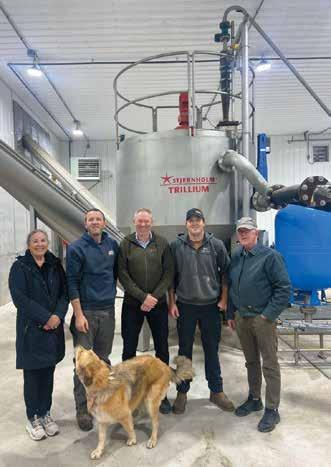
“This level would be achieved with plow tilling,” Young said. “For example, a farm could apply liquid manure in the spring when ready to plant corn and come back through with a disc or chisel plow to incorporate manure into the soil. You see a little less reduction in ammonia loss when using no-tillage tools.”
Young said a shallow disc produces decent results above 90% reduction in ammonia loss, whereas an aerator-band system would be less effective, reducing ammonia loss by two-thirds to threequarters. Both units can be used in hay elds or corn elds.
“A shallow disk injection unit more effectively reduces ammonia and other soluble nutrient losses in runoff than an aerator-band unit,” Young said. “The aerator doesn’t quite get it in the soil as effectively.”
In addition to ammonia capture, Young said another benet of these systems pertains to water quality and runoff.
“By mixing that manure into the soil, it’s less vulnerable to runoff during rain events and snowmelt losses,” he said. “If manure is broadcast on a corn eld or hay eld versus being incorporated into the soil, it sits on the surface and is much more vulnerable to being lost in surface runoff.”
At the Midwest Manure Summit Feb. 26 in Green Bay, Dr. Horacio AguirreVillegas, a scientist at the University of Wisconsin-Madison, shared results from a study on ammonia emissions from conventional, organic and grazing dairy farms. During his presentation, AguirreVillegas highlighted how the farms’ unique management practices impacted how much ammonia was emitted.
–Stjernholm technology, farm distributor and dealer –here


Thirteen dairy farms were modeled: ve conventional, ve organic and three grazing. Farms ranged in size from 501,000 lactating cows and maintenance animals. Aguirre-Villegas said diet composition determines the nutrients in excreted manure.
“Organic and grazing dairies feed more pasture and forages which have more crude protein and nitrogen in the diet,” he said. “Higher crude protein results in higher nitrogen excretion that has a potential to be emitted as ammonia throughout manure storage and land application. During the grazing season, manure is excreted on the pasture in small pockets, creating high concentrations of nitrogen, which might not all be utilized by growing pastures as opposed to a controlled application of manure on growing crops when manure is stored and land applied.”
The study revealed farm size does not signicantly affect results when expressed per excreted manure. Despite a reduced surface area exposed to wind because it is stacked, solid manure has higher ammonia levels than other forms of manure due to its higher pH, which is one of the main drivers of ammonia emissions, Aguirre-Villegas said. When looking at storage, the average pH was 7.4 for liquid manure, 7.8 for slurry, and 8.5 for solid manure.
Liquid manure or slurry, which has less total solids, has higher inltration rates into the soil, and therefore reduced ammonia emissions from land application. Barns have the lowest ammonia emissions when compared to stoarge and land application, except for two organic farms with bedded packs, as those create ideal conditions for ammonia to be emitted.
“Higher temperatures create more opportunity for ammonia to be lost,” Aguirre-Villegas said.
The study revealed that the top practices for reducing ammonia emissions
were solid liquid separation and injection, which reduced ammonia loss by about 40%. Injection alone lowered ammonia loss by 30%. Reducing crude protein in the diet reduced ammonia loss by more than 20% as did a combination of anaerobic digestion, solid liquid separation and injection. However, anaerobic digestion and solid liquid separation without injection could increase ammonia emissions Aguirre-Villegas found if proper management is not applied. Furthermore, he found compost increases ammonia emissions by 25% from high temperatures and aeration caused by turning the compost.
Research conducted at the UWMarsheld Agricultural Research Station is aligned with the Ruminant Farm Systems model for testing and validating best practices, such as manure incorporation and crop rotation on nutrient losses. This whole-farm simulation model is designed to simulate all major nutrient ows on a dairy farm, including manure generation and nutrients in manure, as well as milk production. Young’s role in its development includes soil and water module aspects.
“We’re honing in on crop production, fertilizer, manure, runoff and nutrient cycling in the eld,” he said. “A lot of our work up at the station is designed to help test that model by applying different types and rates of manure. The model will take this into account and provide recommendations.”
For example, if a farm has 100 acres and applied X amount of manure to a eld that has been in corn for three years in well-drained soil with a certain pH, the RuFaS model will calculate nitrogen recommendations based on those inputs.
“You can look at these cascading levels across the whole farm and change different variables and test different scenarios,” Young said.
The RuFaS model is still in development and will be free for all to access once available.

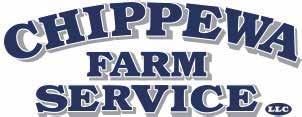
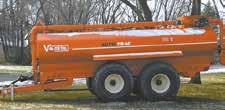


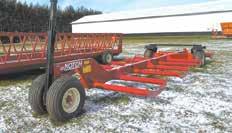
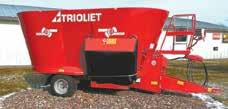
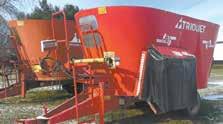









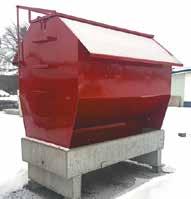
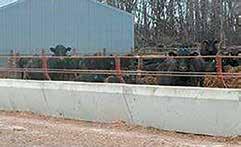





















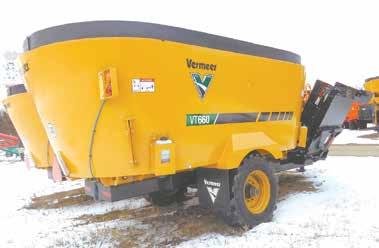



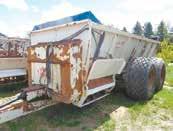
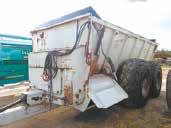
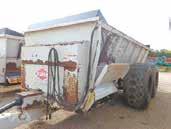
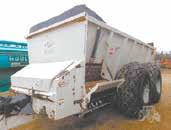

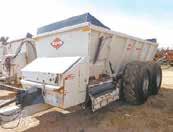
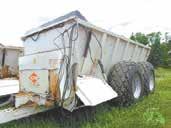


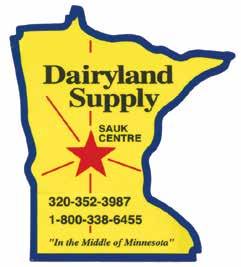

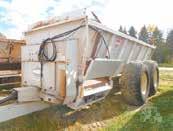


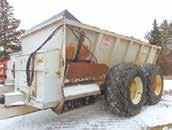

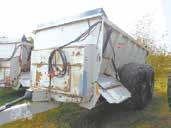

Joel
Groetsch Sauk Centre, Minnesota
Stearns County 120 cows
Tell us about a recent vacation you took. We are leaving in a couple weeks for Cabo, which is on the west side of Mexico. Usually, we go to the east of Mexico but decided to change it up this year.
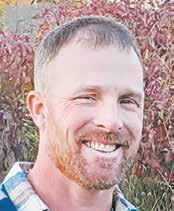
What made you decide a vacation was in order? For my wife and I, it is a de-stressor. You go to relax and unwind so you can come back refreshed and ready to go. I farm with my brother; every January, he goes on a trip with his wife, and every February, I go on a trip with my wife.
What logistics did you work through in order to leave the farm? I farm with my brother, Josh, and between him, his kids and my kids, it is not too difcult since we have robots. We line it up so the kids get up with Josh in the morning; then, they can drive to school. It really helps that we have each other to balance out chores when ei-ther one of us wants to leave so we don’t have to hire anybody extra. The kids help out on the farm enough to understand what to do.
Tell us about your best vacation. Jamacia. It was a smaller, all-inclusive hotel that had a pool bar and a nice beach. It was small enough that we got to know the other people at the hotel. I liked it because we didn’t have to walk as far to get to the beach and got to know the other people. Also, there were a lot of farmers from the U.S. there.
What is the return on investment, for you personally, when you take a vacation? I think everybody needs to get away to have some downtime to appreciate what you have. You feel so much better when you get back. It gives you something to look for-ward to instead of the same routine every day.
If you could take a trip anywhere in the world, where would you go? It depends on how long I could get away. If I could, I would go all over Europe, and not the tourist places. I want to experience the rural areas to get to know the agriculture and the communities. I would also like to go to Japan someday; it is something different.
Tell us about your farm. I farm with my brother, Josh, and we milk 120 cows with two Lely milking robots. I have three boys, and he has two boys who help on the farm, too. We are the second generation on our farm. We farm 800 acres of corn, soybeans and alfalfa.
Josh Kraska
Pine Grove Dairy
Swanville, Minnesota
Morrison County
70 cows
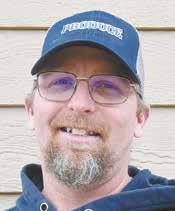
Tell us about a recent vacation you took. Last fall, I went elk hunting in Colorado. I was there for a week with two of my brothers and a nephew. We rode horses seven miles out to a camp, then stayed at that camp for a week. It was really fun.
What made you decide a vacation was in order? My brothers and I do a hunting trip every fall. We go to Colorado, Wyoming or Montana every year. What logistics did you work through in order to leave the farm? I farm with my brother, Dan, and we are partners at the dairy. We take turns going on vacation so we can both get time off. It makes it so much easier to get away because one of us will always be here to take care of things.
Tell us about your best vacation. One winter, we took a 2-week family vacation to Florida. We drove and spent time in St. Lois, Fort Meyers and Orlando and swam in the ocean. We did Universal Studios in Orlando. My in-laws spend the winter in Fort Meyers, so, we spent some time with them. We went in the winter because it is easier to get away for an extended amount of time.
What is the return on investment, for you personally, when you take a vacation? Rest, recharge, refresh. It’s also good for the kids. We made a lot of memories on the Florida trip and had good family bonding.
If you could take a trip anywhere in the world, where would you go? I would take my wife to Europe. I don’t have a specic place in mind, but we have that in the back of our minds.
Tell us about your farm. I farm with my brother, Dan, and we milk 70 cows in a stanchion barn. We farm about 800 acres of corn, soybeans and alfalfa. We are the third generation on our farm. Our wives work off the farm, but my two sons help with chores now. We ship our milk to Bongards.
Troy Colsrud Finlayson, Minnesota Pine County 70 cows
Tell us about a recent vacation you took. My wife and I went to New Mexico to visit her parents. We visited family and took a hot air balloon ride.

What made you decide a vacation was in order? My wife and kids wanted to see their parents and grandparents. Winter is a nice time to get away to feel some warmer weather.
What logistics did you work through in order to leave the farm? I had my oldest son come home to take care of the feeding, and my other two boys, a junior and senior in high school, took care of the milkings.
Tell us about your best vacation. Alaska. We went salmon shing and did the Alaska Grand Circle. That was a scenic highway drive from Tok to Fairbanks, Gateway and back again. It is more than 1,000 miles but is very scenic and shows the diversity of Alaska. Totally worth it.
What is the return on investment, for you personally, when you take a vacation? Coming back relaxed and refreshed. I can’t sleep in while on vacation, but it is still a good time to recharge and relax.
If you could take a trip anywhere in the world, where would you go? Australia. Just to see what the country, culture, agriculture and people are like. It sounds so different than here. I’m curious what their setups are like.
Tell us about your farm. I farm with my wife, Vicki, and kids, Jake, Justin, Loren and Joe. We milk 70 cows in a step-up parlor. I am the second generation on this farm. We raise all our own crops of corn and alfalfa and our own replacements. We plan to put up a new shop this year on our farm.



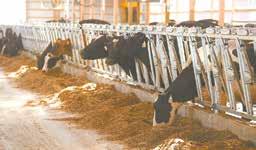
Tom Gregory Mill Creek Dairy Kimball, Minnesota Stearns County 650 cows
Tell us about a recent vacation you took. In recent years, my vacations have been conventions through the Soil and Water Conservation District. They usually last three days. This consists of a type of in-service where a facilitator picks your brain. I am a Stearns County supervisor, and there are many issues we contend with. These conventions give us a lot of opportunities to network with other SWCDs and discuss various issues.

What made you decide a vacation was in order? This happens every year in early December. It’s the time of the year when the real farm workload is over, and it’s a nice time to get away.
What logistics did you work through in order to leave the farm? I come and go often. I am 70 years old. We have lots of help; I can do most things ahead of time, and my son or brother can cover my regular duties for me.
Tell us about your best vacation. My best vacation occurred when my daughter was completing college. We were nishing work on a new barn, and she called me to see if I wanted to go to Australia. She had gotten a good deal for tickets. I said yes, and we quickly harvested the fourth crop of alfalfa. When we left, we ew to California, then to Fiji for a couple of days, and then, nally, Australia.
Rick Balzer
Balzer Family Dairy LLC
Owatonna, Minnesota
Steele County
140 cows total herd

Tell us about a recent vacation you took. We went to Aruba this winter. This is the 10th year we have been going there. We go to the same resort — we always rent somebody else’s timeshare. We relax in the sun, but not too much because the sun is pretty intense, so we nd a palapa to sit under and we both usually read a book. For me, it’s the only time I truly read a whole book. We also wade through the pool and meet new people. This year we met a man from Toronto, Canada. We sang karaoke to “Friends in Low Places” by Garth Brooks. (I did not know that I could sing so well — not.) We also hang out with old friends and play bingo and dance.
What made you decide a vacation was in order? In the beginning, it was a nice reset to life. Now, we look forward to going.
What logistics did you work through in order to leave the farm? In the beginning, our sons were still at home, and we went when they had winter college break. My dad was still helping with chores so we could get away. If not for our sons and my dad, it might not have been possible to go.
Fiji was like taking a 40-year step back in time. We hired a tour guide who took us all over. He dropped us in a village, and we mingled with the village people. Fiji was so far behind our time they harvested sugarcane by hand with machetes. The people were very kind, and they had very little.
Then, we were off to Australia. Every night, we came back to the hostel and talked to the people there. They had traveled from all over the world and were from different backgrounds, but we could easily share stories and humor. At night, we would also plan our trip for the next day. Snorkeling the Great Barrier Reef was incredible, and we did twice. White water rafting was also great and so was crossing the Great Divide. We traveled to the Outback. We toured a dairy farm, it was very interesting; he had 300 cows and did all grazing. He had a little dingy building where he milked his cows. We saw 20 kangaroos in a group, and we stopped and took a ton of pictures. We were really excited
What is the return on investment, for you personally, when you take a vacation? It’s a change in perspective. You think of your operation differently, and you think about how you can make your business more productive.
If you could take a trip anywhere in the world, where would you go? New Zealand. The people I’ve talked with and the reading I’ve done makes it sound like a very interesting place to visit.
Tell us about your farm. Mill Creek Dairy was built in 1997 and started with 250 cows milked in a double-8 parlor. When we grew to 300, we expanded to a double-12 parlor. In 2012, we increased our cattle numbers again, up to 550. Now we have around 650 cows. We milk all the cows on one site, but we do have four sites where we have young stock and cattle. We have around 15 employees, full time and part time. We crop around 1,200 acres, which is a combination of rented and owned land. Our crops are corn and alfalfa.
Tell us about your best vacation. One of many was going to national peddle pull in Omaha, Nebraska. Our oldest son won state and so we could take him to nationals. We all went: my wife, the four boys and me. From Omaha, we went up to the Black Hills, South Dakota. The Black Hills are special because that’s where my wife and I spent our honeymoon.
What is the return on investment, for you personally, when you take a vacation? It’s just a good reset and chance to visit with old and new friends. It is an opportunity to see how other parts of the country are doing. As I mentioned, we have met people from Canada, Philadelphia, Connecticut, North Carolina, Miami and upper New York.
If you could take a trip anywhere in the world, where would you go? If we could go anywhere in the world, we would maybe go to Germany. Medford School has had foreign exchange students, and there was a young lady in our son’s class we got to know pretty well and she had been out to our farm. She had been learning how to drive, so I was teaching her how to drive our Ford Ranger stick shift. It was quite a challenge, but she got it eventually. Over the years, she has come back to visit, so it would be nice to go visit her.
Tell us about your farm. We farm 500 acres of corn, soybeans, alfalfa and oats. The 120 milking cows are milked in two robotic milking units. We raise all of our heifers and nish out our steers.

Five ladies (from left) April Klaphake, the daughter of Mark and Jennifer of Sauk Centre, Haddie Walter, the daughter of David and Cathy of Sauk Centre, Jaiden Smith, the daughter of Jeremy and Emily of Melrose, Bella Schiffler, the daughter of John and Kristie of Albany, and Daisy Zimmermann, the daughter of Mike and Lori Zimmermann of Sauk Centre were crowned Stearns County dairy princesses March 15 at the Freeport Community Center in Freeport, Minnesota. Klaphake and Walter won the Stearns County ADA scholarships and Ava Smith, the daughter of Jeremy and Emily Smith, was named miss congeniality. Ambassadors are Chloe Hoppe, the daughter of Travis Hoppe and Amy Hoppe of Albany, Megan Frieler, the daughter of Duane and Amy Frieler of Greenwald and Ava Smith.


















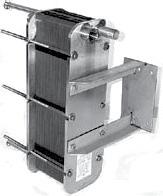

With DeLaval VMS V300, it all revolves around you, which is why we have developed the V300 to be the world’s most exible milking robot–so that it works for you and not the other way around. Whether your operation is small or large, the VMS V300 can help you farm your way.





How many times a day do you milk, and what is your current herd average, butterfat and protein? We milk twice per day. Our rolling herd average is 30,214 pounds of milk, 1,313 pounds of butterfat and 992 pounds of protein, with component tests of 4.5% butterfat and 3.3% protein.
Describe your housing and milking facility. Fresh cows and cows that need extra attention are housed in deep-bedded sand stalls in a barn with the dry cows. The rest of the milk cows, which is the majority of the herd, are housed in a freestall barn with waterbeds and bedded with chopped straw. Cows are milked in a double-8 parallel parlor in the old tie stall barn.
Who is part of your farm team, and what are their roles? Our farm team consists of three owners who manage and run the day-to-day operations. There are two full-time and two part-time employees who help cover the milking shifts. There are six other parttime people who help, mostly family members who help with feeding calves and other jobs where needed.
What is your herd health program? Pregnancy checks are done every two weeks

by our vet using ultrasound. Typically, we meet every two weeks with our nutritionist to go over animal performance and any adjustments that need to be made on any diets. We discuss any concerns and ideas with both our veterinarian and nutritionist to best position our cattle to perform their best. Vaccination protocol on heif-
ers includes giving Alpha-7/ MB-1 and Bovi-Shield Gold FP 5 L5 before breeding, along with a de-wormer. Vaccination protocol on cows includes giving Bovi-Shield Gold FP 5 L5 at 30 days in milk and a Vaxxon SRP Salmonella vaccine and Alpha-7/MB-1 at dry off. Cows also receive a de-wormer twice per year. All cows are
dried off using Quartermaster and a teat sealant.
What does your dry cow and transition program consist of? Dry period is 60 days for rst lactation and 50 days for all older cows. We have a group of dry cows that is housed on a bedded pack, using either corn stalks or straw.
The dry cow ration is made up of corn silage, grass hay and a mineral/protein mix. Cows that calve are put into the fresh cow pen on day one.

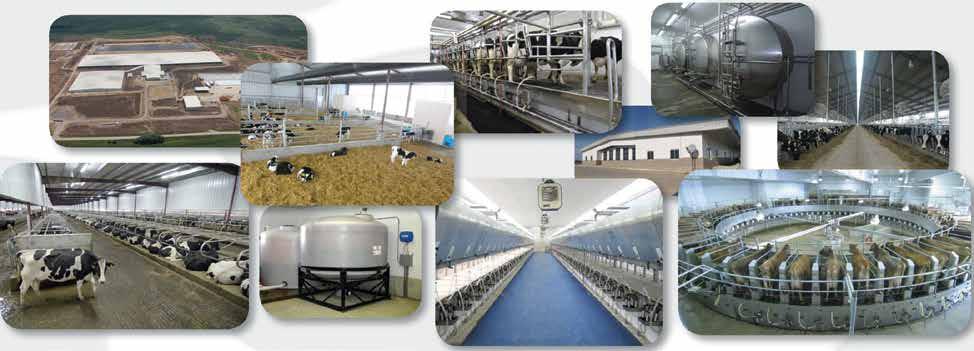
Hoard’s Dairyman article Jan 2025: Staph aureus is a subclinical threat. “Mastitis can be caused by many pathogens, but if you ask any dairy veterinarian or farmer which is the most damaging, the odds are good that their response will be Staphylococcus aureus.” “Staph. aureus is especially dangerous because it persistently infects cows.”
Dr. Justine Britten, Pres. Udder Health Systems, NMC board: “In my personal experience, every dairy is impacted to some degree by Staph. aureus,” and “If Staph. [aureus] was easier to see, farmers would be a lot less tolerant of it.” {Translation – you don’t pay attention to the problem so they will test your milk samples}
Cornell University in Journal of Dairy Science: CoPulsation™ prevents new Staph a. infections by 16:1 YOUR MILKING SYSTEM IS RESPONSIBLE FOR THE PROBLEM! TridentPulsation™ System
607-849-3880 • 607-352-0053 Trident@TridentPulsation.com



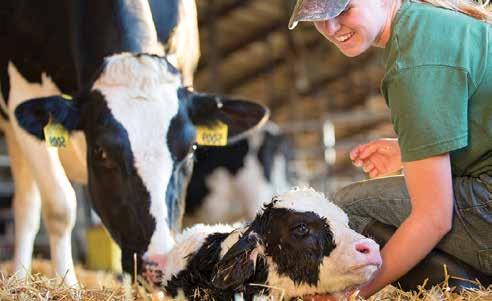
Cow comfort is more important than ever in today’s times of tight milk margins and reduced numbers of dairy replacement cattle. Protect your cattle investments and capitalize on them. Help your herd reach its genetic potential with fresh starts that pay back dividends. Nothing impacts cash flow like problem-free lactations and smooth heifer transitions. Got fresh cows? Get Comfort... with Udder Comfort!TM

“Soft, comfortable udders that milk out quickly and completely have a big impact on milk quality and performance,” says Erik Hagedoorn, managing one of two Bos Dairies locations near Lovington, N.M., milking 5400 Jersey cross cattle, calving over 30 a day.
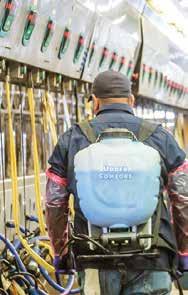

“We rely on Udder Comfort for routine use in our hospital groups and for our fresh cows at the start of lactation.
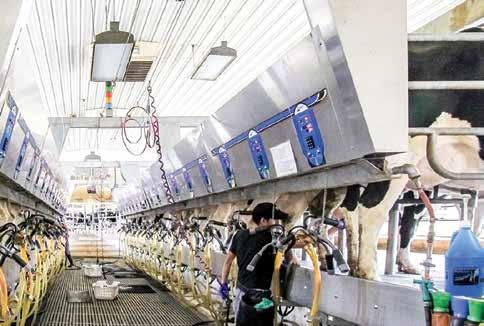


“When outdoor conditions decline, we increase our preventive use. It works like a charm,” Erik adds. At Beer Cattle Co., Berne, Ind., 250 heifers calve-in monthly.

“We use Udder Comfort after each milking for 5 to 7 days after calving to remove swelling. This gets udders softer, faster, for more milk,” says Keith Beer. “We saw better first-lactation performance in our 2-year-olds with a 3 to 4 pound production increase at 14 DIM, and a reduced SCC for the group. We love how easy it is to do this in the parlor,” he adds.
time, money,













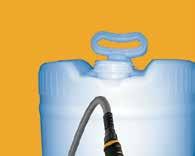


What is the composition of your ration, and how has that changed in recent years? Our milk cow diet consists of corn silage, haylage, ground corn and a protein mix. The ration is usually between 58%-60% forage. This has been a very similar diet we have been using for many years, aside from recently removing cottonseed. Over the past couple of years, we have been and currently are experimenting with a cocktail mix consisting of grasses and clovers and how it might t into our cow diets. There are multiple reasons behind looking into this, with a main focus on improving cow health and soil health.
Tell us about the forages you plant and detail your harvest strategies. We grow all of our own forages and grain corn. Corn silage varieties are picked with a focus on digestibility. Alfalfa is harvested four times, sometimes ve times per year, with 28-32 days between cuttings. On alfalfa, our goal is to have a relative feed quality of 150-190. All forages are harvested by a custom chopping crew.
What is your average somatic cell count and how does that affect your production?
Average SCC is 120,000. We installed waterbeds one year ago and have seen how much more comfortable the cows are compared to the old mats we used. We have just installed a Lely Discovery Collector, and we hope this will help lower
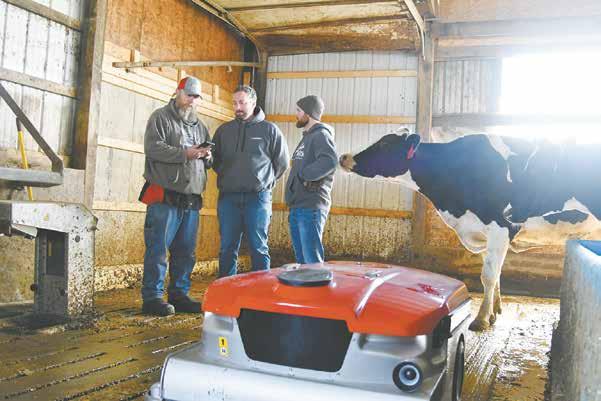
farm near Winona, Minnesota. The Prigges said they hope this will lower soma c cell among other things.
SCC as well as result in fewer cases of mastitis and ultimately lead to healthier cows.
What change has created the biggest improvement in your herd average? The biggest change was putting more focus on putting up higher quality forages and working with our nutritionist to feed for higher levels of production. Although this is what we believe to be the biggest contributing factor to a higher herd average, it still all starts with teamwork and
communication between everyone on the farm.
What technology do you use to monitor your herd? We don’t have any technology directly tied to the cows. We use Dairy Herd Improvement Association testing to help make management decisions on cows along with DairyComp for cattle records. We have a robotic feed pusher and, recently, a robotic manure collector. We have looked into different monitoring systems
for the cows but haven’t committed to anything at this time.
What is your breeding program, and what role does genetics play in your production level? We start breeding heifers at 13 months. All cows are on a double ovsynch program for their rst breeding, with average days in milk at rst breeding being 80 days. We breed with sexed dairy semen and beef semen. We started genomic testing heifers in 2020 and use sexed dairy



semen on our highest genomic testing heifers and cows and the rest get beef. We focus on health traits and components when picking bulls. We have had fewer health-related issues and have continued seeing higher components in rst lactation heifers since we started genomic testing.
List three management strategies that have helped you attain your production and component level. One: communication between everyone involved with the day-to-day chores to outside labor, like the vet and nutritionist. Two: being able to adapt our thinking when facing challenges and having the willingness to embrace change. Three: being open-minded to new ideas, being open to thinking outsidethe-box and always having the desire to learn something new.
Tell us about your farm and your plans for the dairy in the next year. We are the second and third generations on our dairy and have been milking cows at our current location since 1972. We raise all of our own heifers and feed out all beef crosses to nish. We grow all of our own crops. We have no major plans for the coming year other than the robotic manure collector which was just recently installed. It all starts and ends with giving all the glory to God and having the opportunity to do what we love in caring for the land and cattle.

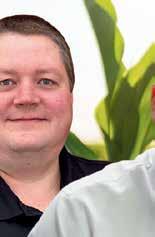



















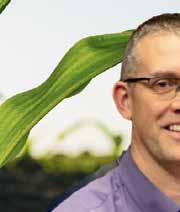










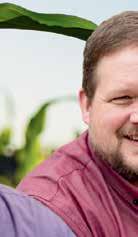












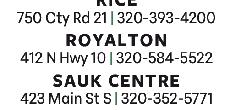









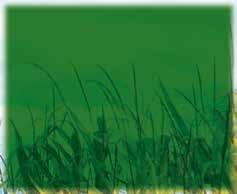









JD S780 2023, 490 hrs., 358 Sep hrs.,PRWD, Duals, #572927
S780 2023, 605 hrs., 318 Sep hrs., PRWD, Duals, #573365

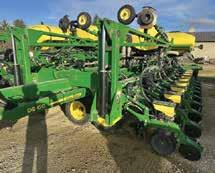








S780 2021, 1233 hrs., 925 Sep hrs., PRWD, Duals, #588551 .............. $329,900
JD S790 2023, 691 hrs., 390 Sep hrs., PRWD, Duals, #573286 ................ $519,900
JD 2680H 2021, 35 ft.,



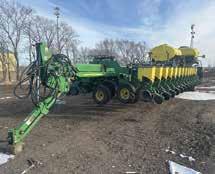


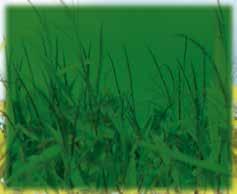




JD DB60 2017, 13900 Est. Acres, 24 row, 30” spacing ,
JD DB60 2015, 39666 Est. Acres, 24 row, 30” spacing, #566673
JD DB60 2013, 31093 Est. Acres, 24 row, 30” spacing, #578708
JD DB60 2010, 24 row, 30” spacing, #569759.........................................
JD DB66 2022, 15600 Est. Acres, 36 row, 22” spacing, #584419
JD DB66 2022, 3260 Est. Acres, 36 row, 22” spacing, #584423
JD DB66 2022, 9060 Est. Acres, 36 row, 22” spacing, #576258
JD DB66 2019, 33000 Est. Acres, 36 row, 22” spacing, #584411
JD DB66 2019, 29422 Est. Acres, 36 row, 22” spacing, #584389
JD DB80 2006, 32 row, 30” spacing , #586764 ........................................
JD DB88 2016, 40000 Est. Acres, 48 row, 22” spacing, #584456
JD DB88 2012, 60000 Est. Acres, 48 row, 22” spacing, #589832

JD 1770NT CCS 2011, 25000 Est. Acres, 24 row, 30” spacing, #590808......
JD 1770NT CCS 2007, 16 row, 30” spacing, #589399 .................................
JD 1770NT CCS 2005, 25500 Est. Acres, 16 row, 30” spacing, #592309......
JD 1775 2019, 3500 Est. Acres, 12 row, 30” spacing, #578706 ...................
JD 1775NT 2023, 1500 Est. Acres, 16 row, 30” spacing, #579850 ...........
JD 1790 2013, 18500 Est. Acres, 24 row, 20” spacing, #591922
MF 9200 2017,


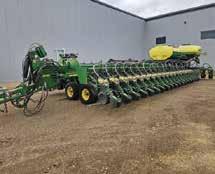



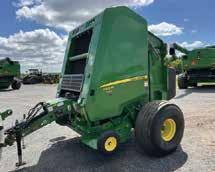






















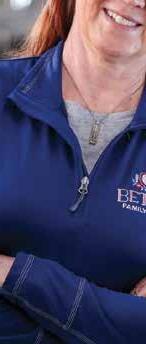
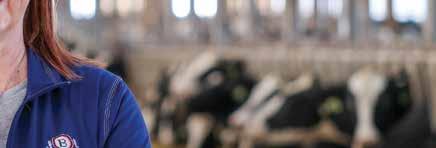





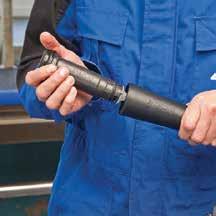

Prairie Land Ag Supply Inc.
Rock Valley, IA 712-476-9290
United Dairy Systems, Inc.
West Union, IA 563-422-5355 Monticello, IA 319-465-5931 WISCONSIN Advanced Dairy Spring Valley, WI 715-772-3201
Bob’s Dairy Supply Dorchester, WI 715-654-5252
Ederer Dairy Supply Plain, WI 608-546-3713 DeLaval Dairy Service Kaukauna, WI 866-335-2825
Refrigeration Inc. Withee, WI 715-229-2321 Mlsna Dairy Supply Inc. Cashton, WI 608-654-5106
Dairy Services Arlington, WI 608-635-0268 Redeker Dairy Equipment Brandon, WI 920-346-5579
MN 218-632-5416
Tell us about your family and farm. My husband, Ray, and I bought our farm from his parents. We raised our four kids — Roger, Amber, Joshua and Allyson — here. Allyson is farming with us now. We started with tie stalls in the barn and transformed this into a swing-8 parlor with a bedded pack barn for the cows. We raise our own replacements and calve mid-March to midNovember. We don’t have facilities for cold-weather calving.
What is a typical day like for you on the dairy? We start milking around 5 a.m. Ally and I do the milking while Ray feeds the cows. After breakfast, I clean the parlor and holding area. I do all the cooking, especially when we have eld work or harvesting help. We start milking again around 5 p.m. Afternoons are meant for lawn mowing, gardening or baking.
Tell us about your most memorable experience working on the farm. My most memorable experience has been watching our kids grow into the adults they are now. Our kids have worked and learned from grandparents who help us farm.
What have you enjoyed most about dairy farming or your tie to the dairy industry? I have enjoyed working with my husband and now working with our daughter. The other kids have helped


Cheryl Seibert Sebeka, Minnesota Wadena County 65 cows
while they lived at home. Our other daughter lives nearby and helps when we need her.
What is your biggest accomplishment in your dairy career? Raising four kids with a passion for agriculture.
What are things you do to promote your farm or the dairy industry? Since nieces and nephews all grew up coming to the farm, they now bring their families to watch milking and learn how to milk.
What advice would you give another woman in the dairy industry? Dairy cows are a 24/7 job. Take time off whenever possible, even day trips help.
What is a challenge in the dairy industry you have faced, and how did you overcome it? Milk price has been a challenge. We have put projects on hold because of low prices. As prices got better, we took on those projects. We live and farm in sand, so water retention for crops is an issue. We installed center pivots.
When you get a spare moment, what do you do? I like to read in my spare time. I grow a vegetable garden and keep our yard mowed. I like to bake. We live close to the Crow Wing River and like to canoe.
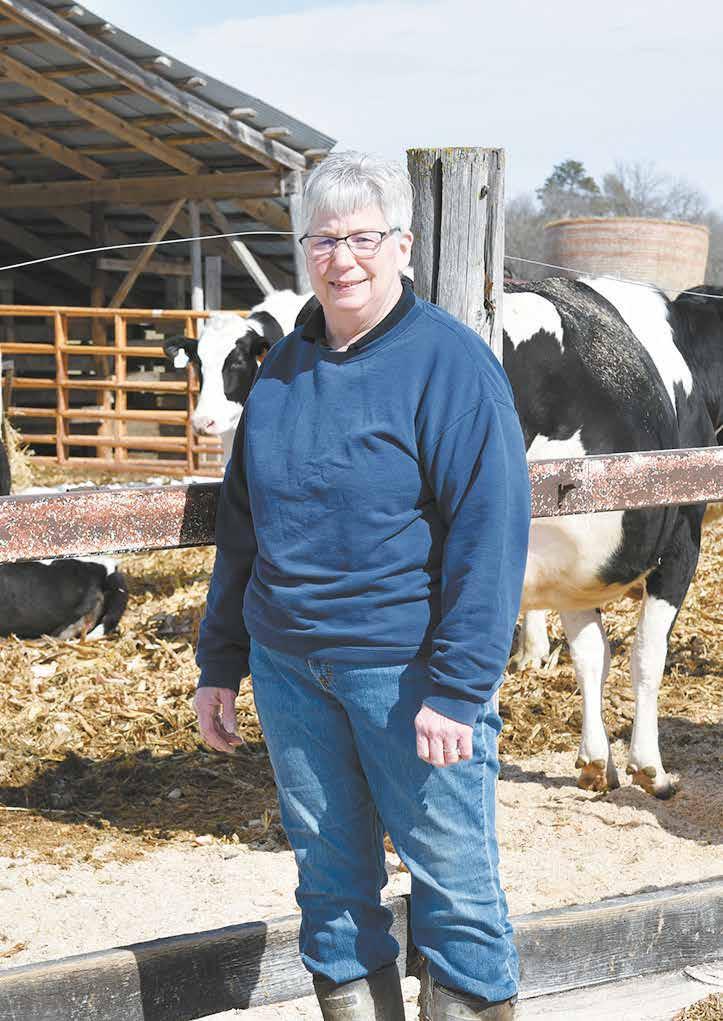
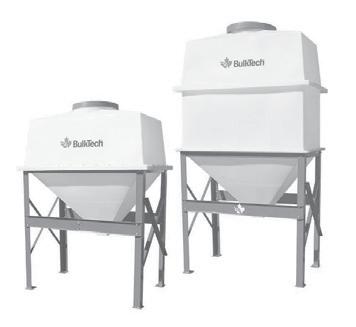
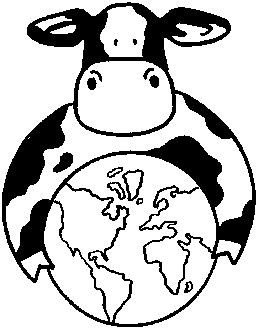












SEEDDAYSSPECIAL
Expires03/29/25 PulaskiWarehouse $5OFF
Each50lb.bagof Magna-Red RedClover (Abovevarietyonly)
MagnaRed,50lbs.....................................$149.95
MediumRed,50lbs...................................$139.95 MammothRed,(Annual)50lbs.................$129.95
AlsikeClover,50lbs...................................$149.95 YellowBlossomSweet,50lbs...................$159.95 CrimsonClover,(Annual)50lbs..................$67.95 BerseemClover,(Annual)50lbs...............$114.95 LadinoClover,50lbs..................................$229.95 WhiteDutchClover,50lbs.........................$249.95 BalansaWhiteClover50lbs......................$134.95
MISCELLANEOUS
HybridSorghum-Sudangrass,50lbs..........$43.95
BMRSorghum-Sudangrass,50lbs.............$65.95 WildGameFoodSorghum,50lbs...............$54.95 RapeSeed,50lbs........................................$59.95 JapaneseMillet,50lbs................................$49.95 PearlMillet,50lbs.......................................$94.95 SunflowerBlackOil,1lb...............................$3.95 Sunflower,GreyStripe,1lb.........................$11.99 AustrianWinterPeas,50lbs.......................$39.95 DiakonRadishes-Tillage,50lbs..................$85.95
HairyVetch,50lbs.....................................$114.95
Flax,50lbs...................................................$59.95
Buckwheat,50lbs.......................................$36.95
SEEDDAYSSPECIAL
Expires03/29/25 PulaskiWarehouse $5OFF
Each50lb.bagof Mor-Leaf Timothy (Abovevarietyonly)
Mor-LeafTimothy,50lbs...........................$105.95 ClimaxTimothy,50lbs.................................$95.95
OrchardGrass(late),50lbs.......................$139.95 OrchardGrass,50lbs................................$129.95 SmoothBromegrass,50lbs......................$159.95
ItalianRyegrass(Annual),50lbs................$59.95
TetraploidAnnualRyegrass,50lbs.............$49.95
TetraploidPerennialRyegrass,50lbs........$99.95
FestuloliumPerennialRyegrass,50lbs....$109.95 MeadowFescue50lbs..............................$129.95
TallFescue,50lbs........................................$99.95
SwitchgrassCave-In-Rock,1lb.pls...........$14.99
ReedsCanarygrass(lowalkaloid)50lbs.....$309.95
SEEDDAYSSPECIAL
Expires03/29/25 PulaskiWarehouse $10OFF
Each50lb.bagof Hay&PastureMix or$5OFF each25lb.bag
AlfalfaForageMix,50lbs..........................$179.95 AlfalfaBaseMix,50lbs.............................$169.95 CloverBaseMix,50lbs.............................$144.95 HorsePastureMix,25lbs............................$74.95 MaxForageExtenderMix,25lbs................$59.95 WildLifeCloverMix,50lbs.......................$219.95 AlloftheabovemixesaremadewithDura-LeafPlusAlfalfa, Magna-RedRedCloverandMor-LeafTimothy
Kewaunee,50lbs.........................................$20.95 Uncert.Robust,50lbs..................................$17.95
Triticale,Spring,50lbs................................$19.95
Alfalfa-Clover,Treats50lbs..........................................$8.95 Trefoil,Treats50lbs........................................................$9.95 SoybeanTerraMaxDry,Treats500lbs.-10unit.........$18.95 SoybeanTerraMaxDry,Treats2000lbs.-40unit.......$48.95 Cell-TechLiq.Soybean,Treats50units........................$93.95 ExceedDeerPlotInoculant,Treats100lbs..................$10.95 (Treatsmorethen96varietiesofseed) INOCULANTS
SEEDDAYSSPECIAL Expires03/29/25
Each50lb.bagof Athletic,Sunnyor ShadyLawnSeed
AthleticLawnMix,50lbs..........................$119.95 SunnyLawnMix,50lbs.............................$129.95
ShadyLawnMix,50lbs.............................$119.95
AnnualRyegrass,50lbs..............................$49.95 PerennialRyegrass,50lbs........................$104.95 CreepingRedFescue,50lbs.....................$119.95
KentuckyBluegrass,50lbs.......................$119.95
TurfTypeTallFescue,50lbs........................$99.95 WhiteDutchClover,50lbs.........................$249.95
Weed&Feed(Trimec)22-0-5Formula $27.99/50lb.bag.Covers12,500sq.ft. CrabgrassPreventer(Dimension)19-0-6Formula $25.99/50lb.bag.Covers12,500sq.ft
Lawn&GardenLime,50lbs..........................$3.59 PelletizedLawn&GardenLime,40lbs.........$6.99 PelletizedGypsum,40lbs..............................$9.99
Cert.Antigo,bu.-early.................................$13.50
Cert.Badger,bu.-early................................$13.50
Cert.Rushmore,bu.-mid............................$13.50
Cert.Esker2020,bu.-mid...........................$13.50 Cert.Goliath,bu-late...................................$13.50 ForagePlus,bu.-Late..................................$13.75 Uncert.Ogle,bu.-mid..................................$12.50 Uncert.Jerry,bu.-mid.................................$11.50
ForageFieldPeas,40-10,50lbs.................$22.95 50%Pea-50%OatMix,50lbs...................$22.95 50%Pea-50%BarleyMix,50lbs..............$22.95 50%Pea-50%Tritcale,50lbs....................$22.95
Krug,90Day,56lbs.....................................$96.95 ReidsType,100Day,56lbs.........................$96.95 HenryMoore,110Day,56lbs......................$96.95 BooneCountyWhite120Day,56lbs...........$96.95
SugarAnn,56day,50lbs..........................$119.95 LittleMarvel,63Day,50lbs......................$119.95
SugarSnap,64day,50lbs........................$109.95 GreenArrow,68Day,50lbs.......................$109.95 OregonGiant,69Day,50lbs......................$109.95 Wando,70Day,50lbs................................$119.95 GARDENPEAS
BoltXR,bi-color,66day.............................3,000Kernel/$42.95 CatalystXR,bi-color,66day......................3,000Kernel/$42.95 NorthernXtra-Sweet,67day.....................3,000Kernel/$32.95 Signature,bi-color,73day.........................3,000kernel/$43.95 AnthemXR,bi-color,73day.......................3,000Kernel/$42.95 X-traTenderXTH2475,bi-color,75day....3,000Kernel/$40.95 Honey’NPearl,bi-color,76day.................3,000Kernel/$32.95 IlliniX-traSweet,85day...........................3,000Kernel/$31.95 KandyKorn,89Day...................................3,000Kernels$29.95
MANYOTHERBULKGARDENSEEDSTOCHOOSEFROM: Peas,Beans,Carrots,Cantaloupe,Beets,Squash,Pumpkins, Watermelon,Radishes,Gourds,OrnamentalCorn,Etc.
WildlifeCloverMix,50lbs.........................$219.95
ImpactForageCollards,3lb.......................$13.99
HunterBrassica,3lb...................................$16.99
WinfredBrassica,3lb..................................$16.99
GrazaRadish,3lb........................................$19.99
SmallBurnett,3lb.......................................$17.99
Chicory,1lb...................................................$7.95
SugarBeets,1lb...........................................$5.95 Plantain,1lb.................................................$6.99
Rutabaga,3lb..............................................$14.99
BarKantTurnips,3lb..................................$12.99
Kale,1lb.........................................................$4.99
RapeSeed,50lbs........................................$59.95
Turnips-PurpleTop,50lbs...........................$89.95
WidowMakerBrassicaMix,25lbs...........$124.95
BrassicaBrunchMix,25lbs......................$124.95
WildGameFoodSorghum,50lbs...............$54.95
BuckBuffet,25lbs......................................$18.95
BuckForageOats,50lbs.............................$39.95
SwitchgrassRCBigRock,1lb....................$15.99
SwitchgrassRCTecumseh,1lb..................$15.99
SwitchgrassCave-In-Rock1lb.pls..........$14.99
EgyptianWheat,4lb...................................$14.99
GameFenceGrowerFoodPlotScreen,4lb. ...$14.99
By Amy Kyllo amy.k@star-pub.com
ST. CHARLES, Minn. — For Bill Powel-Smith, growing healthy crops in a sustainable, cost-effective manner comes down to three takehome practices: ditching monoculture for diverse, multi-family forage elds; understanding how soil moisture impacts nutrient availability; and applying manure onto green cover.
“The conventional system says we’ll provide you all the products to kill everything that’s there and then we’ll provide you with the products to feed your crop,” Powel-Smith said. “We kill off the weeds and kill off the insects, and we kill off everything else, and we plant the mono crop. … We’re promoting the growth of one species in the soil. … There’s no natural predation, there’s no competition and so we’re ghting Mother Nature.”
This is hard on the eld. By growing other plants, the variety of nutrient needs keeps the soil more balanced and less compacted.
Powel-Smith said elds need not only species diversity but also plant family diversity. For example, this could look like a eld containing grass, legumes and broadleaf plants.
“It’s the families that make a difference,” Powel-Smith said. “I get more families in there, I can start driving soil health better, build more structure.”
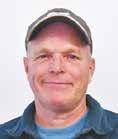
Bill Powel-Smith
Powel-Smith owns his own soil health consulting business, LandCares Consulting LLC. Powel-Smith was the guest speaker for the Driftless Area Ag Alliance’s annual meeting Feb. 10 in St. Charles.
Healthy soil starts with a proper carbon-nitrogen ratio of the organic matter, which Powel-Smith said is 10:1.
“If I’m building a diet for a cow, I’m going to build it around protein and energy,” he said. “(If) I’m looking at building a healthy soil, I’m going to build it around the same two things. We just call it carbon and nitrogen.”
He said for many dairy farmers, their ratio is off because they remove carbon in the form of forages and apply nitrogen in the form of manure. This can lead to unbalanced soil with low organic matter and higher soil nitrogen.
Powel-Smith said farmers should consider planting their elds with multiple species of forages instead of monoculture alfalfa. One of the reasons for this is soil density. Alfalfa tightens soil by pulling out carbon.

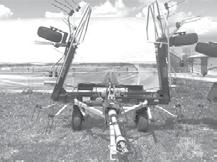
This soil structure can help retain water and limit erosion.
Powel-Smith said multispecies elds can feel like a mess that need to be sprayed and cleaned up.
“This is really what we’re looking for,” he said. “Not only do you bring diversity to your soil, but look at the diversity you bring into that rumen.”
The nished crop is dairy quality feed he said. With a multispecies eld, the goal Powel-Smith said is to get similar yields while eliminating one cutting compared to monoculture alfalfa elds.
“The thing with cutting alfalfa is it’s hugely expensive,” Powel-Smith said. “It costs a fortune.”
Powel-Smith said planting cover crops helps with nutrient uptake from manure. He said rye, triticale and wheat are good options.
“These grasses are great for sucking up nutrients,” he said. “I don’t want nutrients moving to the soil prole. Get them tied up in your plants, and then let that cover crop break down in the summer.”
Powel-Smith said one of the best ways to capitalize on potential soil nutrients in manure is to apply it to green growing elds.
“I can terminate that crop, and it’ll release (the nutrients) as 100% plant available,” Powel-Smith said. “It didn’t go on that way, but it’ll come out that way.”
He said cutting cover crops while lush is a good idea because as cover crops grow larger, the nutrient avail-
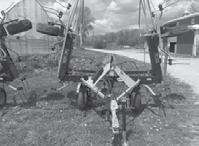

ability to the next crop lessens.
“If you can get your nutrients held up on a cover crop and then released, that’s money in the bank,” he said.
Powel-Smith said farmers should plant shorter day corn and soybeans and reduce trait stacks to give themselves more time to manage their cover crops.
“The prot secret behind this whole thing is, as we go further down this road, we can simplify, simplify, simplify,” he said. “I need less treated traits. I need less cropping inputs. (That) doesn’t mean zero, but I just need less all the time as we build diversity.”
Powel-Smith also discussed nutrient availability and inputs. He challenges the idea of an add and subtract input system, because he said this does not take into consideration soil structure, moisture, and availability of nutrients.
This is why Powel-Smith said he is critical of variable rate nitrogen, because he said it assumes the exact amount, uptake and source of nutrients.
“It’s based on a model that says what you remove, you replace,” he said.
Powel-Smith said farmers should do comprehensive soil testing to understand the nitrogen and phosphorus in their soil as well as other nutrients.
“This isn’t available through voodoo, … it’s available if I can access
and take advantage of it,” PowelSmith said.
Powel-Smith said farmers should get manure analyses and track what manure is spread where.
He said he has been part of doing tissue samples on crops every three weeks to understand how the plants are utilizing nutrients as the season progresses. This is important because soil moisture and other factors can affect whether or not plants can access the nutrients in the soil.
For example, extremely wet, saturated soil can mean increased iron in the plants, which is toxic. The plant will try to compensate by using calcium to bring in aluminum to counteract the iron.
Or, if potassium is abundant, Powel-Smith said this can interfere with the uptake of calcium and magnesium. In fact, he said some research supports the possibility that abundant potassium causes luxury consumption which interferes with the availability of magnesium and calcium.
Overall, Powel-Smith emphasized in his presentation that a diverse eld, with green applied manure, and with soil, manure and tissue sampling, will be on its way to providing healthy feed, a sustainable future, and economic viability.
“Cows don’t lie, soils don’t lie,” Powel-Smith said. “Forage quality will improve and become richer as the soil feeds and protects the crop.”

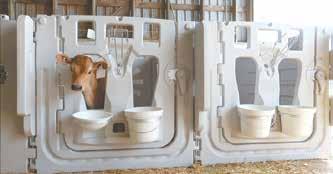




By Dan Wacker dan.w@dairystar.com
BLACK RIVER FALLS, Wis.
Luke Wolsberg and his wife, Lis, always knew they wanted to start a life in agriculture. But land and space to start a dairy was hard to come by in their hometown of Lynden, Washington.
Luke had visited Wisconsin a few times, coming to World Dairy Expo in high school as well as venturing to western Wisconsin for Organic Valley’s annual meeting in 2023. Later that year, the Wolsbergs decided to take the leap. With a truck, a horse trailer and one Jersey calf in tow, the couple moved to western Wisconsin to start a dairy life of their own.
Luke and Lis now operate Double L Dairy. They milk 40 cows in a 9-stall step-up parlor with a 40- by 80-foot sawdust bed pack barn on a rented farm near Black River Falls.
Luke grew up on a dairy farm in Whatcom County in the far northwest corner of Washington. His family had been shipping milk to Organic Valley since 2005. Lis also grew up in agri-




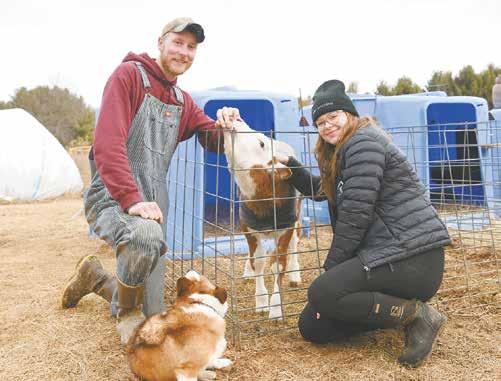
culture, helping on her grandparents’ horse and hobby farm and competing in rodeo.
“I was renting a house, working as a herdsman at a big dairy and we started thinking about our future,” Luke said. “I wanted to pursue homeownership, but the West Coast is really expensive. Lis and I are both rural kids and we wanted property. Having the

experiences I had with bigger dairies, our goal was to have our own small family farm.”
With dairy in his heart, Wolsberg worked at a variety of farms. He spent time at a 50-cow Brown Swiss farm, a 1,000-cow operation and was a herdsman at a 1,500-cow dairy across the river from his family’s farm. Seeing his family’s cows out on grass helped







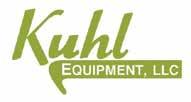


him realize how he wanted to operate his own dairy.
“I was working for a great family and it was a great opportunity in Washington,” Luke said. “But on the bigger dairies, you’re working with numbers and there’s less connection. We knew we wanted a smaller operation and getting the cows out on grass was a big factor for me. Being within an hour of the processing plant was important too, so we knew we wanted to be in western Wisconsin, southeast Minnesota or northeast Iowa.” Wisconsin was not the ultimate goal, but a timely trip helped convince Lis that this was the right place for their dairy.
“We had plans to go to the beach in May of 2023, but Luke had gotten us tickets to visit Wisconsin last minute,” Lis said. “That was the perfect time to come. It was beautiful.”
Although ownership was the initial emphasis, meeting with a Farm Service Agency loan ofcer steered them to the renting option. This enabled them to gain experience operating their own dairy and building years to qualify for a young farmer loan.
“Renting and living off the farm wasn’t what we pictured at rst,” Lis said. “We wanted to be on our farm and walk out our back door to milk cows. But renting has allowed us to get to know our new state better.”




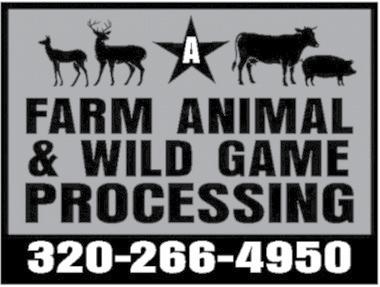
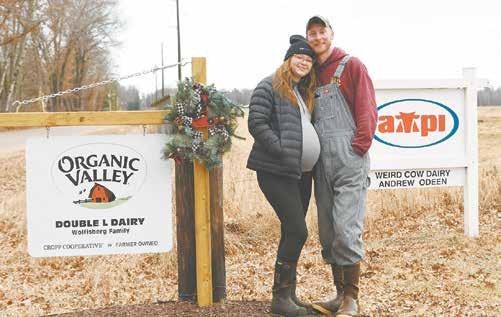
Lis and Luke Wolsberg stand near their farm sign March 3 near Black River Falls, Wisconsin. The couple relocated from Whatcom County in Washington to start their own dairy.
After making the move to Wisconsin in spring 2023, the Wolsbergs were in line to rent a farm that fall, but miscommunication derailed the opportunity.
“We were about to sign the paperwork to rent our rst farm, but we realized not everyone was on the same page with the transition,” Luke said. “It made us nervous because we moved halfway across the country for this opportunity, and we couldn’t just go home.”
The two farm kids rented an apartment in the city of La Crosse that winter, picking up off-the-farm jobs. Lis worked as a bartender and barista, with Luke going to work at the Organic Valley-Chaseburg Creamery.
“Those six months off the farm really helped us get acclimated,” Lis said. “We got to know a new city, a new state. We had some time to really embrace what Wisconsin was about.”
For the rst time in his life, Luke was not working on a farm. The new experience provided more perspective of the dairy industry.
“It was cool to be on the inside and see how it works on that side of the industry,” Luke said. “It was an eye-opening experience.”
Finding their community became more the goal than nding a farm during those winter months. Meeting new people, making friends and exploring the area brought them to their new farm near Black River Falls.
“I started making some phone calls about farms to rent last spring,” Luke said. “At that same time, some friends we had met at church texted us randomly and just asked if we were
still looking for a farm to rent.”
Andrew Odeen, a fourth-generation farmer who milked a conventional 30-cow dairy, had recently sold his herd. His land was certied organic as his neighbors, David and Will Peasley, were renting the land. The Peasleys tipped off the Wolsbergs about the potential of working with Odeen.
“Andrew was a little hesitant to us renting at rst,” Lis said. “He reached back out to us pretty quickly and we sat down and started putting a plan together. He could really see our vision. He’s great to work with and he’s the best landlord we could have asked for. He’s been open and honest with us. He built the facility almost by himself and knew that we would care for the facility like he would.”
The Wolsbergs lled the barn by purchasing cattle from neighbors and the area’s organic community. They are renting 80 acres, 60 of which will be pasture this spring with 10 going towards corn to make feed in the fall.
“We want to let the cows graze as much as we can,” Luke said. “We wanted enough land to keep cattle outside May 1 until Dec. 1.”
Starting a dairy nearly 2,000 miles from home has been difcult, but the power of community has helped the Wolsbergs realize their dream in western Wisconsin.
“One of the biggest challenges was just guring out who to talk to about what,” Luke said. “Back home I knew who to call for feed or equipment, but here we were starting from scratch. Everyone we’ve worked with has felt like they’ve been on our side.”

The story begins at birth, as a dairy producer you don't get a second chance with calf health.




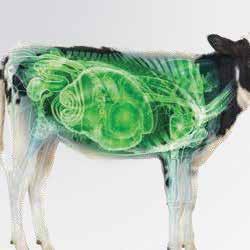

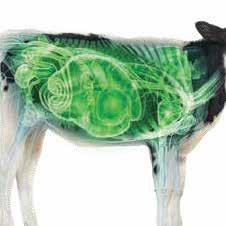











GutVersity
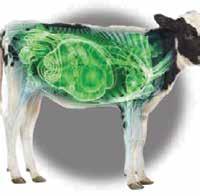




Prebiotics, diverse strains of probiotics and postbiotics. When calves are young the goal is to feed the gastrointestinal tract.
Egg Proteins Targets pathogenic organisms.
An increase in bacterial burden leads to an increase in intestinal permeability, bacterial translocation and absorption of endotoxins.
(Immune Positioning System)
A unique blend of biologically active polysaccharides and polypeptides. IPS provides unmatched immune support for your calves.


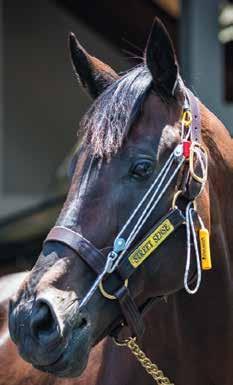

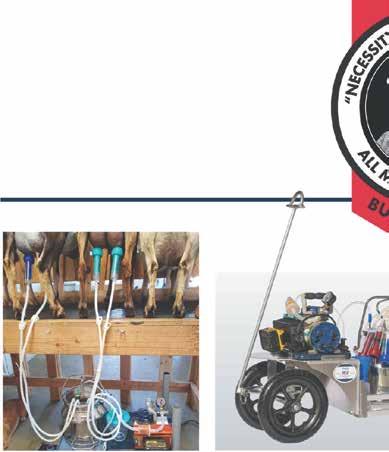
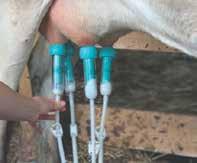


Ultimate EZ™ Electric Milker is 100% portable, operates using 110V or power tool batteries, includes bottles, stainlesssteel buckets and many accessories.
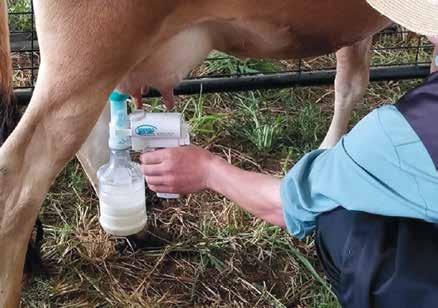



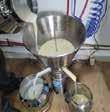
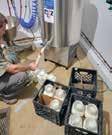
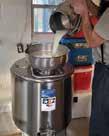
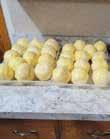


By Amy Kyllo amy.k@star-pub.com
HASTINGS, Minn. — Amelia Miller is not afraid of trying new things, whether it is responding to a local dairy farm’s help wanted ad with no dairy experience or being one of six girls on her high school wrestling team the year girls wrestling was sanctioned in Minnesota.
Miller, the daughter of Rob Miller and Amy and Jarrett Bjork, is a senior at Hastings High School in Hastings. This year, Miller’s wrestling record was 34-5. She set the Hastings High School girls wrestling single season record for pins with 27. She has 54 career pins, which is the all-time record for the program.
“(It was) an absolutely phenomenal season for her,” said her coach, Tim Haneberg.
Miller said work ethic has been part of her plan for success.
“I always try to be the rst one in the (practice) room and the last one out,” Miller said.
Outside wrestling, Miller makes time to work on a local 100-cow dairy farm owned by John and Janet Bremer near Hastings.
Haneberg said Miller has selfcondence, accountability and grit. Haneberg has been the head wrestling coach at Hastings for six years and coached for 14.
“The keys for success, … (I think are) a strong work ethic and a positive attitude,” Haneberg said. “Those are two things that Amelia has shown over the last four years.”
For the past two years Miller has been a section champion and a state entrant.
“I denitely had a re inside going into this year wanting to do good,” she said. “The entire season was getting ready for state, hoping to do something there because I always had a goal to get on the all-state wall and have a picture next to my dad.”
Miller’s dad, step-dad, uncle and brother have all wrestled. This year was Miller’s third year as a team captain.
“(Being captain) is something that is very special to me,” Miller said. “My dad, he was a captain. … He was a big reason that I joined the sport ... following in his footsteps, and then to be someone that the girls can look up to is really nice.”
At state this year Miller woke up sick and did not perform as well as she had hoped. Miller was the only girl from Hastings returning to state this year.
“I was still really glad to make it again, having my last year up there with the girls and watching them place,” she said.
Miller’s rst year of wrestling was in 2021 as a freshman. Miller and a handful of other students competed. Haneberg recruited girls whose brothers wrestled for the inaugural team.
“These are some pretty brave girls

COURTESY
Miller
state tournament
and senior years.
that came out for a pretty male dominated sport,” Haneberg said. “She was one of those rst six girls that really took that challenge head on.”
Miller did not see a lot of success her rst year.
“I got 10 matches the entire season, maybe 12, and I denitely had a lot more losses than wins,” Miller said. “We would go to the places that the boys went, and it was just a give or take if they would have a girl that’s around your weight.”
The next year she began getting more matches. By junior year she had a 17-16 record and the team had grown to 26 girls. This year, the team had 37 girls. Haneberg said Miller helped in the growth of the program.
“For her to stick it out those four years, continue to (personally) grow and grow and grow is really cool,” he said.
Haneberg said he has seen Miller’s self-condence soar as a result of wrestling.
“She just has done a great job of showing condence in other girls, inspiring it in them,” he said. “(She is) a leader in the wrestling room, helping those girls with their technique, (and) creating relationships with them.”
Miller grew up on a generational family farm, showing animals through 4-H and participating in FFA. Miller hopes to become a production animal veterinarian and will attend the University of Minnesota-Crookston this fall and plans to apply for the Veterinary Food Animal Scholars Track program. It was this career aspiration that pushed her to apply for the farm position offered by the Bremers.
“Working on the dairy farm is great hands-on experience with the animals,” Miller said. “(I appreciate) being able to watch how a dairy farm runs, and then what kind of problems they see and how they x it.”
Janet Bremer said Miller is an excellent employee who is driven and always eager to learn. Bremer said they prioritize her watching the veterinarian to gain understanding about her future career.
“I just think that’s wonderful she took the initiative to learn about something prior to even entering school,” she said.
Miller’s duties include feeding calves and milking cows. During the wrestling season she was limited to working one day a week, but during the rest of the year Miller works three or four days a week for the Bremers.
As an athlete and dairy farm employee, dairy products are part of Miller’s life.
“Milk is super important,” Miller said. “Our coaches always tell us it’s either water or a glass of milk. That’s what we drink through the season, nothing else.”
Looking to the future, Miller hopes to continue to give back to wrestling as a coach or a practice partner at Hastings and also potentially at the girl’s wrestling program at the high school in Crookston.
Haneberg sees a bright future for Miller’s life.
She’s going to be a very successful girl and a very driven person,” he said.

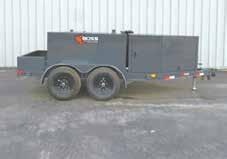

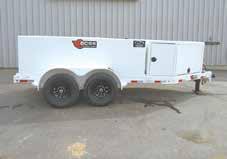
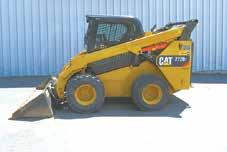

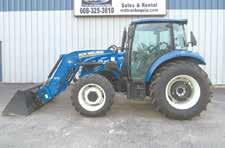









cial dairy cattle genetic evaluations are published three times each year: April, August and September. This is when bulls receive updated Predicted Transmitting Abilities for genetically evaluated traits such as fat yield, Daughter Pregnancy Rate or livability. While minor changes may occur between evaluations, this April will see a few larger changes. This is because the formula used to calculate Lifetime Net Merit will be updated and because we will experience a base change.

yield receives less emphasis. Other changes include increased emphasis on heifer and cow livability, less emphasis on productive life and increased emphasis on feed intake traits. If you are interested in seeing the exact changes that will occur when Net Merit is updated in April, I encourage you to visit the Council on Dairy Cattle Breeding’s website (uscdcb.com/introducingnet-merit-2025/).
By Isaac Haagen University of Minnesota
First, let’s address the anticipated changes with Net Merit. Net Merit is updated every several years to reect recent trends in income and experiences experienced by dairy farms. For instance, if the monetary value of fat or protein changes, Net Merit can be adjusted to place more or less emphasis on these traits. Indeed, this is the case for the 2025 update to Net Merit as fat has increased in value relative to protein in recent years; therefore, fat receives greater emphasis in the new Net Merit calculations, while protein
The last time Net Merit was updated was 2021. It is important to note that the relationship between Net Merit in 2021 and Net Merit in 2025 is extremely high. In fact, the correlation between Net Merit in 2021 and Net Merit in 2025 is 0.981 for progeny proven bulls. This means that, across all animals that receive evaluations, there will be slight reranking; however, it is still possible some animals will re-rank more than others. Secondly, we will also experience a genetic base change this April. This happens every ve years in the United States. Therefore, the last time we experienced a base change

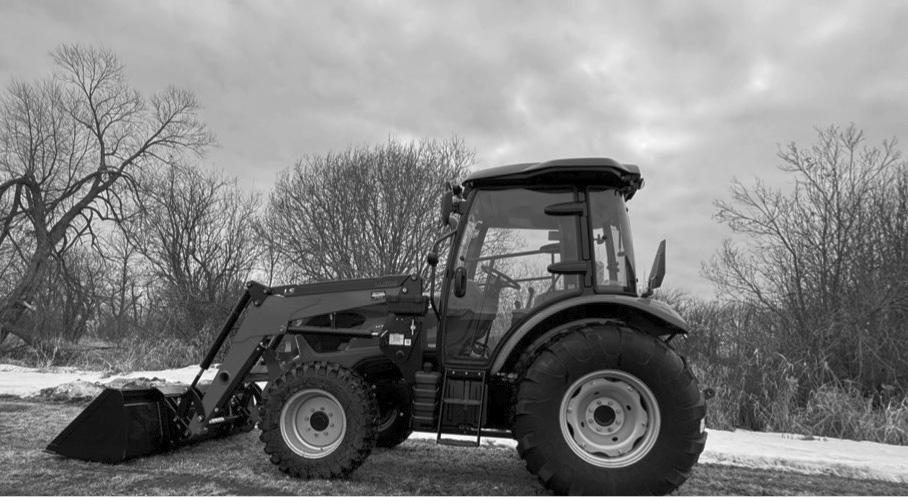
was in 2020. For the upcoming base change, the average PTA values for animals born in 2020 will be set to zero. For most traits, such as yield traits and livability traits, PTA values will be adjusted down to reect that the average PTA values for these traits have improved.
For example, if the average PTA for fat yield increased by 20 pounds for animals born in 2020 compared to animals born in 2015, this reects that animals have improved 20 pounds in PTA fat yield during that
Dana Adams adam1744@umn.edu 320-204-2968
Luciano Caixeta lcaixeta@umn.edu 612-625-3130
Gerard Cramer gcramer@umn.edu 612-625-8184
Marcia Endres miendres@umn.edu 612-624-5391
Brad Heins hein0106@umn.edu 320-589-1711
Nathan Hulinsky huli0013@umn.edu 320-203-6104
Karen Johnson ande9495@umn.edu 320-484-4334
Emily Krekelberg krek0033@umn.edu 507-280-2863
Claire LaCanne lacanne@umn.edu 507-332-6109
Brenda Miller nels4220@umn.edu 320-732-4435

time. However, it also means PTA values for fat would be 20 pounds lower in the April 2025 genetic evaluation compared with prior evaluations to reect the base change. It is important to note the exact changes have not been nalized at the time of writing this article.
These changes to our national evaluations are infrequent but routine and will result in evaluations that more accurately reect the dairy industry as it exists today.
Isaac Salfer ijsalfer@umn.edu 320-296-1357
Jim Salfer salfe001@umn.edu 320-203-6093
Mike Schutz mschutz@umn.edu 612-624-1205
Melissa Wilson mlw@umn.edu 612-625-4276
Isaac Haagen hagge041@umn.edu 612-624-7455
Michael Boland boland@umn.edu 612-625-3013
Sabrina Florentino slpore@umn.edu 507-441-1765
Scott Wells wells023@umn.edu 612-625-8166
Erin Cortus ecortus@umn.edu
Recently, I’ve found myself having many conversations about goals. Whether it’s a conversation about my own goals or someone else’s, there is always the same theme: making goals stick.
Goal setting is important to both personal and business success. Goals help us work toward desired results and provide a point of guidance. Goals can be aimed at short-term issues, long-term projects and everything in between. Goal setting can also be used as a resilience strategy to promote organization. No matter what type of farm you have or what stage you or your farm are at, goal setting is important. The way we set our goals can also determine whether we are successful in achieving them. There are several questions to consider when setting goals:
likely you will have multiple shortterm goals you are working on at once, so it’s also vital to consider prioritizing your goals.

By Emily Krekelberg University of Minnesota
First, are the goals SMART? SMART is an acronym for specic, measurable, attainable, relevant and timely. As you write each goal, ask yourself, is it specic? Is it measurable? Is it attainable? Is it relevant? Is it timely? If it isn’t SMART, identify what needs to be changed or added to the goal for it to meet the SMART guidelines. This method is a great way to get started with setting both personal and business goals.
Second, what is the timeline for the goals? Thinking about goals in both the short term and long term can also make them more achievable. Typically, anything you want to accomplish within a year is a short-term goal. If the goal has a timeline greater than a year, it is a long-term goal.
Short-term goals can be written as a to-do list. Write them down and put them somewhere they will be seen often. For farm goals, this might be the fridge or somewhere in a breakroom. For personal goals, this could be on your computer or your bathroom mirror. This way, you will be reminded about them often and be able to achieve them in the set amount of time. Short term goals typically require less time and resources, or they may be short term due to urgency. It’s
Long-term goals should also be written down and very thorough. It may be benecial to break long-term goals into smaller goals to keep things on track. If the overall goal is to be achieved in ve years, consider if there is a oneyear goal for each of the ve years. For example, if a farm goal is to improve reproduction, perhaps you can reach a certain benchmark within one year and then build on that benchmark in subsequent years. This can help reduce overwhelm and make even large goals feel more attainable. Whether goals are short or long term, they should be written down and have a timeline.
Third, are these everyone’s goals? Specically for farm goals, it is crucial to communicate and share goals with everyone involved on the farm. A process often used for goal setting in farm transfer situations can also be useful in setting any type of goal on the farm. This can be especially useful on multi-generation farms and on farms with multiple managers. This three-step process involves developing, blending and prioritizing goals. In the rst stage — developing — individuals draft their own goals for the farm. In the second stage — blending — you share and combine your goals with the people you work closest with; this may be your spouse or siblings or whoever is in your generation on the farm. In the last stage — prioritizing — all people and generations on the farm come together to share their goals and create one, prioritized list. Creating goals for a business together can help ensure “buy-in” from everyone involved, as everyone gets included in the process.
Goal setting is important for any farm, as it keeps the business moving forward to the next step. Using these questions as a guide, take your rst steps toward setting some goals that stick.
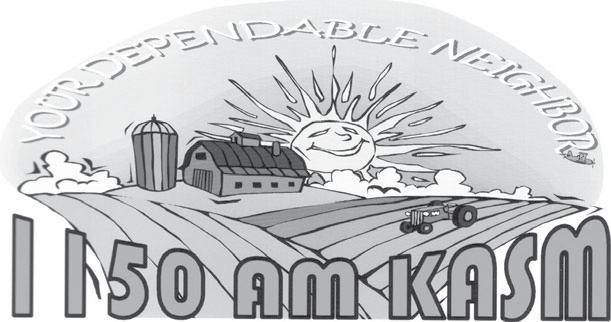




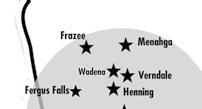
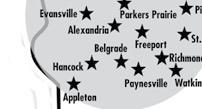

















By Amy Kyllo amy.k@star-pub.com
FREEVILLE, N.Y. — It is not every day that 50 lm professionals and a former “Saturday Night Live” star from Los Angeles spend a week on a dairy farm in rural New York. However, for Beck Farms LLC, November 2023 brought just that scenario as they were the hosts for the documentary mini-TV series “Dairy Diaries.”
“It was this classic commingling between city mice and country mice,” said Tyler Beck, one of the owners of Beck Farms “(There was) two worlds, this (lm) production world, coming together with on-farm agriculture, and it was pretty wild to see everyone interact. … It was a once in a lifetime deal that was fun.”
Beck Farms was chosen out of 80 dairies across the U.S. that applied to be the host for “Dairy Diaries.” The show was sponsored by the U.S. dairy community and several dairy industry organizations.
Beck dairy farms alongside his brother, Austin, their semi-retired dad, Russ, managing partner, Jerry Coller, and their employees. The Beck family’s farm is split between two locations near Freeville. One dairy houses 800 cows milked twice a day in a double-8 herringbone parlor. The other dairy, where the TV series was lmed, houses 1,200 cows milked three times a day in a double-20 parallel parlor.
The documentary TV show featured Vanessa Bayer, who was on “SNL” for seven seasons, spending part of a week learning how to be a dairy farmer. Throughout the ve episodes of the show, Bayer milks and feeds cows, helps haul manure, hangs out with a veterinarian, rides along with a milk truck driver, helps out at a dairy processing plant and learns about the latest innovations in dairy from Dr. Joseph McFadden, a faculty member at Cornell University.
The Beck family’s proximity to Cornell University was an advantage of their location, plus all the owners at Beck Farms are alumni.
The show is lighthearted as Bayer jokes and asks lots of questions. Miranda Abney, vice president of consumer marketing with MilkPEP, said Bayer’s curiosity helped take the series to the next level.

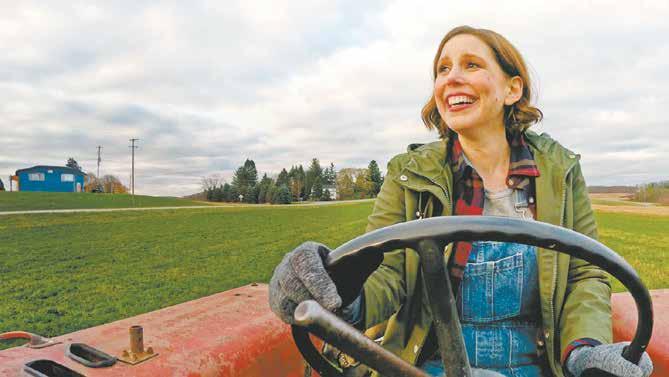
“She was asking the questions that … the everyday person, … wanted to have answered,” Abney said. “She had such a good rapport with everyone, and was really able to get people to open up and be really natural and engaging.”
The show was not scripted. Instead, each episode had a topic and overall themes, and then Bayer, the Becks and the other dairy professionals on the show shared their story organically.
“It allowed us to speak free owing, and tell people authentically about what we do,” Beck said. “That was very helpful not having to memorize lines, or to have everything be tightly managed.”
The show’s humor was an intentional choice Abney said as a hook to connect to their target audience of younger millennials and older Generation Z.
“They expect entertainment and storytelling,” Abney said. “They’re not really interested in spending time with your content if they’re not going to be entertained while they’re learning. So, we really took an edutainment-type approach.”
The series premiered on Roku in April 2024 with standout numbers. Roku reported it generated 72%

video completion rate, the highest they had ever recorded at the time for a mid-form, 10–20-minute, brand-funded episodic series. The episodes, which ranged in length from 9-11 minutes, with one 16-minute episode, had an average of nearly eight minutes of watch time.
Alison Stelzer, a business lead with GALE who worked on the project with Abney said having the show follow Bayer, a new farm visitor, gave the show strength.
“The sh out of water type of format is always compelling, because … it’s almost like a transformation,” she said. “You want to see where they started with their point of view and where they ended up.”
Though free owing, most scenes had multiple takes with a day of lming creating about enough content for an episode Beck said.
“It was probably more exhausting than most weeks I’ve ever done on the farm,” Beck said. “It’s the stress of hoping everything goes right and nothing goes wrong, and they get to see what they want to see. … Going to bed every night, it felt like you worked a 20-hour day.”
Since it was lmed in November, the season of the year and what was going on at Beck Farms was a determining factor for what was shown.



The crew from Los Angeles set up on a Saturday and packed up the following weekend. They brought in three recreational vehicles and portable bathrooms and used the Beck’s old shop as headquarters to store cameras and equipment. To help not disrupt the dairy, they tried to contain lming to one location at a time. Film crew was instructed on how to act safely around the cows.
After watching the show, viewers had improved perceptions of dairy milk and dairy farming according to a Roku brand lift study.
“It was presented in a way that broke down a little bit of the walls that people put up when this kind of information is shared,” Stelzer said. “It disarmed people. … That is hugely indicative of a successful piece with a topic that can be polarizing.”
The series was aimed at renewing interest in milk as a modern beverage Abney said.
“A lot of times people forget about milk,” she said. “We wanted to tell the story about how we are thinking about the future. There are new products and developments. We’re always working on new technologies and on-farm practices that will help contribute to healthier people and a healthier planet.”
Beck hopes the show will make a difference for the dairy industry.


“When we have a chance to speak rawly about what we do and show real footage, it does wonders … on (showing) what actually goes on and what a modern-day farmer looks like,” he said.
We haven’t had a female cat — and, thus, kittens — on the farm in over ve years. All of that changed last weekend.
Good Life
As we drove into the yard after 4-H Dairy Project Bowl practice last Sunday, I spotted a small, unfamiliar black cat staring us down from inside our garage. I pointed the cat out to the Monika and Daphne and we all proceeded to the garage for a closer look. The little cat, which was clearly still a kitten, albeit an older one, greeted us with hungry, plaintive meows. The kitten, who is solid black with just a freckle of white on her chest, let Daphne and Monika pet her while I went to get some cat food and water.

discussion began about what to name the adorable black kitten. Character names from books the girls have recently read were suggested. Words synonymous with the color black were proposed. The name we all felt t the best was Onyx. The little kitten’s silky, black fur reminded us of a polished onyx stone.


By Sadie Frericks Columnist
Judging from her empty appearance and appetite, the poor thing hadn’t eaten in awhile. When her tummy was full, we made her a little nest with an old towel in a cardboard box. I started sending messages to neighbors and employees, guring she had either wandered over here or hitched a ride in someone’s vehicle. (The last new cat to arrive on our farm came on the trailer that picks up our bull calves.) Nobody knew who she was, so it looked like she’d be staying.
Just like when a new calf arrives, a

Later that night, after bringing the garbage out, I heard Onyx meowing at me from under our parked van. I stooped and called for her, hoping she’d come out so I could scratch her ears. She quickly came to my call. And then another black-asmidnight kitten came trailing after her. “What the heck? Who are you?” I said aloud.
I popped back into the house to tell the kids that there were now two black kittens and then led the new kitten to the garage to show her where the food and water were. At this point, I began to doubt that these kittens arrived here by accident. We had pondered over the winter about adopting a couple new barn cats this summer, since our current barn cats are getting pretty old. I guess sometimes someone else makes the decision for you.
The kids came out to meet the new
kitten, who appeared to have gone a few less days without nourishment before we found her. Since she was just as black and silky as Onyx, we decided her name should be Obsidian.
Onyx and Obsidian settled into their new home in our garage quite well. I had forgot how much fun it is to watch kittens chase after blowing leaves or curl up in a shaft of sunlight. Onyx did give me a bit of a scare on Tuesday when I found her meowing from inside the engine compartment of one of our trucks. Maybe these kittens did manage to hitch a ride here. Or, wherever they lived before, they became very accustomed to playing around and hiding in vehicles.
On Wednesday night, I saw Monika drive into the yard after youth group and then heard her call from the front door: “You guys, you’ve gotta come see this.”
I proceeded to the front door and found Monika standing on the steps with three black kittens. The newest black kitten was considerably thinner than the other two and appeared to have trekked through either our cow yard or heifer yard — her legs were covered in halfdried manure. But she was, by far, the friendliest. She let us pick her up right away and instantly began purring like a chainsaw.
Now, I was really asking myself, “What the heck?” The mystery of these kittens only seemed to be getting more mysterious. Maybe these kittens weren’t
dropped off here, like I had thought. Could someone have been cruel enough to drop them off on a random roadside out in the country? And then they found their way here? Could they all have left their original home together? I know adult cats often migrate, but I’ve never seen kittens up and leave. Clearly these kittens had been socialized and cared for — and had been raised in a garage.
On Thursday morning, Daphne and I cleaned the newest kitten up and decided that her name should be Opal, since opals can be black and we like themed names. Sadly, later that evening, we found Opal had been run over on our driveway. We had lots of deliveries on Thursday afternoon. We don’t know if she climbed up into a wheel well of one of the trucks or if she was just too weak to move out of the way fast enough. She had just found a new home with food and shelter and love after what must have been a harrowing couple of days; we wish she could have enjoyed those comforts for longer.
Onyx and Obsidian are lling out and becoming friendlier. They purr when we pet them and we can hold them briey. They’ve started venturing farther from the garage and they appear to be practicing hunting. Perhaps they’ll become part of the farm’s mousing crew. For now, we’ll keep enjoying their antics and reminding delivery truck drivers — and everyone else — to please drive slowly in our yard.




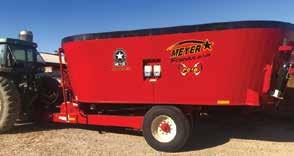





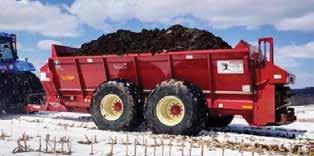




By Steve Frericks Stearns County FSA executive director
Often, the difference between success and failure comes down to preparation. Being prepared in agriculture can often make all the difference. If your forage chopper is not serviced and eld-ready before the pending storm on the horizon, it is impossible to get the crop harvested in a timely manner. Missing that window of opportunity means the next cutting will be delayed.
Missing out on U.S. Department of Agriculture or Farm Service Agency program opportunities can have the same effect. We know your time is very valuable. As the spring presents new priorities, we invite you to complete your FSA program or loan tasks now. Your much-deserved time in the tractor does not need to be interrupted because of something that could be accomplished previously.
Please note the deadlines for our current program signups:
— The Agriculture Risk Coverage and Price Loss Coverage enrollment period for the 2025 crop year is Jan. 21, 2025, through April 15, 2025.
— The Dairy Margin Coverage enrollment period for the 2025 program year is Jan. 29, 2025, through March 31, 2025.
We invite you to call your local ofce to set up an appointment. This will help us better assist you during your ofce visit. This will help us expedite the signup process. Ask our team about all signature options for conducting your business.
Farm records and other changes
If you are making any changes to your farming operation (land sold/purchased, renting new land or






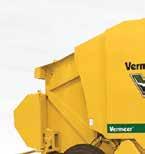



dropping land) please notify FSA immediately after these changes occur. Updating your records now will save you time when signing up for ARC/PLC, reporting your acres, and ensuring maps are ready. FSA is not notied of these sales by the county recorder’s ofce. In addition, notify FSA if your bank account has changed.
Farm loan
We cannot stress enough that if you need FSA direct loan assistance, please reach out sooner rather than later. Many people are seeing cash ow and balance sheets that are less than ideal. Getting on the list will help ensure you receive the best service available.
Farm stress
We know there is a lot of stress in the ag community right now. If you recognize this stress in your family members or friends, do not hesitate to seek the appropriate help. The Minnesota Farm and Rural Helpline is a free, condential service that provides support for people struggling with stress, anxiety, depression or suicidal thoughts related to farm and rural life. The helpline is available 24/7 and can be reached by calling (833) 600-2670, texting FARMSTRESS to (898) 211 or emailing farmstress@state.mn.us.
The question that everyone is asking currently: as of Monday morning, March 17, 2025, when this was submitted, FSA had nothing new to report on the program known as “Farm Act,” ofcially called E-CAP (Emergency Commodity Assistance Program) other than the news release Secretary of Agriculture Brooke Rollins delivered at Commodity Classic.
Her statement is as follows: On the $10 billion in economic assistance passed by Congress, Secretary Brooke Rollins said, “My team has been working around the clock to stand up this process. Today, I am
proud to announce that the economic assistance program will be called the Emergency Commodity Assistance Program, or E-CAP. Congress gave us 90 days to start distributing the rst $10 billion in economic assistance — and we are on track to begin applications on or before March 20.
“I have asked my team to think creatively about how to develop a streamlined application process. We don’t want to be your bottleneck. In cases where we have information already on le, a pre-lled application will be sent to you. FSA will use the 2024 acreage reporting data you previously led to initiate the application process. There will also be an opportunity for you to provide this information if you missed the window. You will be asked to review the information, sign and return the completed application back to your local FSA service center. We are also developing tools to provide fair and transparent standards for calculating payments.”
On the $20 billion in disaster relief, Secretary Rollins said, “We are simultaneously working on rapid implementation of the $20 billion in disaster assistance due to weather conditions outside your control. Unlike the previous administration, we are not going to delay for an entire year — and gone are the days of progressive factoring. No longer will you be required to hand in your tax returns.”
Please know that your local FSA ofce will provide you with information on these programs as soon as possible.
Farm Service Agency is an equal opportunity lender. Complaints about discrimination should be sent to: Secretary of Agriculture, Washington, D.C., 20250. Visit www.fsa.usda.gov for application forms and updates on USDA programs























ltth
From the industry’s rst large round baler to the rst-of-its-kind self-propelled round baler, Vermeer has been the leader of innovation for the hay and forage industry for 50+ years. Continually introducing innovations that change the way you make hay. Of course, there’s MORE to making



than just baling it. Vermeer has a versatile lineup of hay tools and products for every step of the hay making process — from mowing your elds to feeding your herd. Now through April 30, 2025, quali ed buyers can receive low-rate nancing or cash back on select Vermeer products.




March 25 - 27
The Dairy Signal ® Online, noon - 1 p.m., CT
Visit www.pdpw.org to participate in live-streamed event. Audio/video recordings also available free.
March 25 - 26
Carbon, Crops + Cows
Mar. 25: Pagel’s Ponderosa, Kewaunee
Mar. 26: Compeer Financial, Sun Prairie, Wis.
Visit www.pdpw.org for details.
April 1-3; 8-10; 15-17; 22-24; 29-30
The Dairy Signal ®
Online, noon - 1 p.m., CT
Visit www.pdpw.org to participate in live-streamed event. Audio/video recordings also available free.
April 1, 8, 15
Dairy’s Visible Voice ®
Apr. 1: Pagel’s Ponderosa, Kewaunee
Apr. 8: Weiss Family Farms, Durand, Wis.
Apr. 15: Miltrim Farm, Athens, Wis.
Visit www.pdpw.org for details.
Sharing ideas, solutions, resources and experiences that help dairy producers succeed.

We’ve so often heard that the most valuable assets on today’s dairy farms are our people. It’s true; dairies of every size rely on people to care for animals, crops and one another to meet production, profitability and sustainability goals. With fewer young people growing up on dairy farms, it’s increasingly critical to focus on developing our current team members alongside the next generation of dairy leaders, whether or not they come from a farm.
I’ve beneted from several mentors since starting my career in the dairy industry. I grew up on our family farm, McFarlandale Dairy, near Watertown, Wisconsin, then studied dairy science and life sciences communication at the University of Wisconsin-Madison. After graduation, I worked as a dairy nutritionist in northeast Wisconsin for three and a half years before returning to the family farm in 2016 as the sixth generation.
tions, and they still mentor me and help to move our dairy forward.
Because being mentored has had such a positive impact on me, I’m grateful to have had the pleasure to return the favor by mentoring others through the Professional Dairy Producers Mentor Program. Through this program, college, short course and technical school, students are paired with dairy producers to spend a day working side by side with them for rsthand learning.

By Christine Bender
The PDP Mentor Program is a great opportunity for students to get an in-depth look at an active progressive dairy. On our farm, I typically have the student work alongside our calf manager and herdspeople. I also spend time with them, going through the ins and outs of our operation and sharing what we’ve learned over the years.
learn something, too. I enjoy meeting the students and learning about them, their roots and aspirations. It’s reassuring to know there are more bright young individuals interested in our industry.
It is vital for our farms and dairy industry to have bright young individuals who will dedicate their time and energy to ensuring an even brighter future for dairy. Whether on your own farm or through 4-H, FFA or industry and peer-network programs, making the investment to mentor the next generation of dairy leaders will deliver benets in the present and long into the future.
A note from PDP: In January, UWRiver Falls student Isaac DeYoung mentored with McFarlandale Dairy through the PDP Mentor Program. Here’s what he had to say:
Once there, I worked my way up from feeding calves and heifers to serving as lead herdsperson. Today, I’m an owner, overseeing the health of 2,000 cows and about 30 full-time employees.
My rst mentors — my parents — taught me how to take care of the animals, modeled a strong work ethic and instilled a passion for dairy. At CP Feeds, Randy Marx and Dennis Schueller taught me how to formulate diets for cows and consult with dairy farmers to help make them more successful. I continue to lean on several trusted consultants when we have ques-
The mentor program provides students who didn’t grow up on farms the opportunity to see a modern, working dairy farm rsthand and learn if a career in dairy is something they might want to pursue. For students who were raised on a farm, it’s important to experience other operations through tours and even working for someone other than their mom and dad. These opportunities give young people different perspectives on managing dairy farms, exposing them to new ideas and broadening their networks so they can be effective if they decide to return to their home farm.
I’ve found that another great thing about mentoring others is that I always
“Christine opened my eyes to the business side of farming and helped me see that farming is not just a job; it’s a source of pride and joy, an opportunity to take great care of their cattle and ensure they produce the best possible product. This has deepened my respect for the industry and reinforced my passion for working with animals and my commitment to pursuing a career as a large animal veterinarian.”
Christine Bender owns and operates McFarlandale Dairy near Watertown, Wisconsin, with her parents, Peter and Cindy McFarland, and her husband, Robb Bender. They milk 1,700 cows between two sites and are focused on improving and growing their business. The Benders have three daughters.



































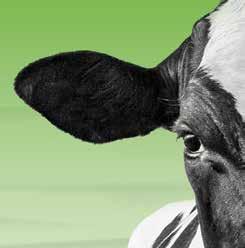


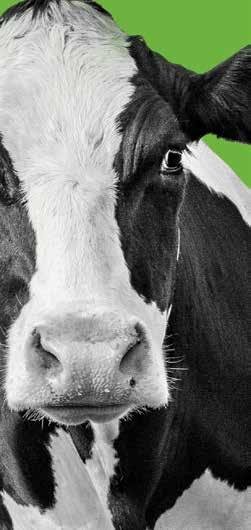










Jennifer Klaphake


Drive west, and the corn and soybean elds gradually give way to wheat and milo, which gives way to rangeland and cattle, which gives way to sagebrush and the occasional bug-eyed antelope. Keep going, and you’ll eventually nd a place where it appears that hell hath boiled over.
Welcome to the super volcano that’s known as Yellowstone.
Some years ago, my wife and I undertook an expedition to Yellowstone. Why? “Because we’re adventuresome” or “We like to learn new things” would be good answers, but in truth, I was inspired by the Yogi Bear cartoons I watched as a kid.

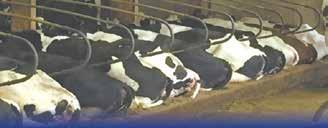
New additive in our paint now prevents & protects against the growth of mold & mildew.
Fiberglass freestalls offer a heightened level of comfort which can lead to an increase in milk production!
NEW PRODUCTS:
• All Solid Rail Fencing has a 20 year UV coating to prevent slivers, Colors available
• Show Fencing & Pasture fencing
• Cattle Panels & Continuous Fencing
• 1’’ & 1-1/4 Electric Fence Post UV Protected
• 13% Chrome Post for Head Locks & Feed Rail
• Guard Rail and Fiberglass posts.
• Lifetime warranty on our fiberglass products from rusting and rotting


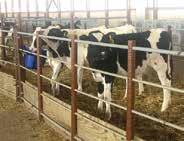


“We installed freestalls from TJ’s Fencing in our new expansion freestall barn. I really enjoyed the durability and longevity of the freestals and gates in my old barn. I will never install a steel post again after using their posts since they will never rust. They are also reasonably priced compared to other options.”

KG4 Farms, Ridgeway, IA
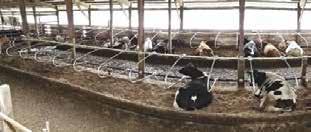



“I have used fiberglass rods from TJ’s Fencing for my pasture fencing for five years. I like how they are durable and nice and solid. I can also tie the high tensile wire right to the posts.”
Jordan Meyer, Caledonia, MN
“I have fiberglass freestalls and my milk production has gone up since we installed them. We love the fiberglass freestalls! I have cows standing in the morning because all the fiberglass stalls are full.”
Steve Kaiser Little Falls, MN
was stopped by an elderly gentleman who asked if he’d missed the eruption. I said it had just nished.

“Was it worth it?” the old guy asked. I said it was. Besides, how many times do you get to sit and watch a scheduled geyser? He decided to hang around for the next eruption, so I can truthfully say I sent a geezer to the geyser. We decided to drive around the park to see what else we could see. Wildlife, especially bears, was high on our list.


By Jerry Nelson Columnist
After white-knuckling through two mountain ranges, we nally arrived at Yellowstone. As we neared Lake Yellowstone, my wife wrinkled her nose and glanced at me accusingly. “It wasn’t me,” I protested.
For once, it wasn’t. The park’s volcanism causes many areas to emit a sulfuric odor. Yellowstone smells farty.
Yellowstone is a land of steam and snow. At the end of May, snow was still thick in the high country while steam rose from the shores of frozen Lake Yellowstone.
Steam pours from random openings in the earth, as if someone is running a humungous underground clothes dryer. These are called fumaroles, from the Latin “fuma,” meaning “really stinky,” and “role,” meaning “hole in the ground.”
There are also geysers. More than half of the planet’s geysers are in Yellowstone, including the most famous of them all, Old Faithful.
The Old Faithful site is highly civilized, featuring a historic log hotel, paved roads, T-shirt vendors and so on. A section of road had just been upgraded, and steam wafted from the new roadcut.
Old Faithful erupts approximately every 90 minutes. We had time, so we waited on the benches provided by the National Park Service.
We heard voices from all over the world. People were speaking French, Russian and Italian. I chatted with folks who were from Germany and saw others who hailed from India and Eastern Asia. It was as if the UN had convened in the midst of the steamy, smelly wilderness.
Old Faithful doesn’t go off with a bang. Its eruption builds slowly, in ts and starts, hufng and chufng and burping puffs of steam like a balky locomotive. As with many highly anticipated events, it was over much too soon.
Strolling from the viewing area, I
It wasn’t long before we encountered a herd of bison. They lumbered slowly across the road as if they owned it. We weren’t about to challenge the horned herbivores’ perception.
Cars clustered at the roadside marked the site of several grazing elk. The elk were so accustomed to being photographed that I wouldn’t have been surprised if a tourist posed with his arm around an elk’s neck.
We soon became adept at spotting wildlife. The main spoor we followed was clumps of cars parked at the roadside. Another useful sign was photographers who had miniature Hubble telescopes bolted to their cameras.
We stopped at one such cluster and were treated to the sight of a lone wolf nonchalantly loping along in the distance.
I spoke to the guy next to me and learned that he was Mike Hassell, a volunteer ranger at the park. I asked him about Yellowstone’s wolf population.
“We have nine packs and about 120 wolves,” he said. “That’s down from about 300 some years ago. Before the wolves were reintroduced, the park had around 14,000 elk; it now has roughly 10,000. The slow and the stupid elk are no longer with us.”
Hiking up to the yawning basin that’s known as Excelsior Geyser Crater, my glasses suddenly fogged over. This had nothing to do with the fact that I was walking briskly uphill at 8,000 feet of altitude. A cloud of steam had billowed over me, exposing me directly to the heat of Earth’s beating heart. I now know how it feels to be a steamed carrot. We never saw any bears, which was a huge disappointment. They must have been out in the forest, doing whatever it is that bears do in the woods.
My guess is they were enjoying picnic baskets.
Jerry Nelson is a recovering dairy farmer from Volga, South Dakota. He and his wife, Julie, have two sons and live on the farm where Jerry’s greatgrandfather homesteaded over 110 years ago. Feel free to email him at jerry.n@ dairystar.com.
Editorial disclaimer: The views expressed by our columnists are the opin- ions and thoughts of the author and do not reect the opinions and views of Dairy Star staff and ownership.


Parasites and insects can negatively impact dairy cattle performance and protability. Now is the time to develop your strategy to limit their impact on your farm.
First, let’s briey discuss mange and lice. These bothersome parasites are present year-round and build during cold weather. They are most often found on cattle necks, backs, hips and tailheads. Controlling these parasites enhances productivity primarily by improving cow comfort and the behaviors associated with it. Treat all cattle on the property at the same time if possible, choosing a time when they are not stressed or in poor condition. If groups must be treated separately, they should be kept apart to ensure no contact between treated and untreated groups.
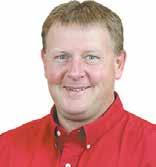
By Barry Visser Nutritionist
Treatment programs often contain a general endectocide to cover both external parasites, such as mange and lice, and internal parasites. Consult your veterinarian or herd health professional for specic recommendations.
Now on to ies, which are a nuisance to farm workers and animals, transmit disease and cause signicant economic loss. Flies cause livestock to expend extra energy by fending them off instead of resting, eating and milking. Fly control is critically important to all dairy operations to reduce the spread of disease and improve animal comfort, resulting in decreased stress and greater efciency of growth or production.
In the past, insecticides often were the sole strategy to manage ies in dairy and livestock barns, but this single-tactic approach can aggravate y populations’ resistance to insecticides and inadvertently destroy natural enemies of ies. Today, farms are suc-
cessfully combining careful use of pesticides with other integrated pest management practices.
Fly identication and biology
Identifying the type of ies on your dairy and understanding their lifecycle is key to developing an effective IPM plan. Common ies found on dairies include houseies, horn ies, stable ies and face ies. Houseies are the most abundant around livestock operations but cause the least irritation. Both horn and stable ies are bloodsucking insects and can be very painful to their hosts. Although house and face ies don’t suck blood, they do spread disease.
According to Purdue University research, a y can complete an entire generation — from egg to adult — within as few as 10 days. All ies pass through four life stages: egg, larva (maggot), pupa and adult. During its lifecycle, which is about 30 days, a housey female can lay up to 1,000 eggs. These eggs are deposited on moist manure or any type of moist, rotten or decaying organic matter. The eggs hatch in 10-12 hours, and the maggots move into the wet manure. Fly maggots mature in 4-5 days under warm, moist conditions. Pupation occurs in the drier parts of manure, with the adult ies emerging in 3-5 days. Although capable of movement up to several miles, houseies normally stay within 0.5-0.75 miles of their breeding sites.
The largest economic return for y control is effective cleanliness and sanitation. Approximately 90% of a dairy’s ies will develop in less than 10% of its physical area. Removal and disposal of wasted feed, spilled milk or manure will go a long way in reducing y populations. Eliminating tall weeds around facilities can reduce attractiveness to ies, especially stable ies. In some cases, alternative bedding sources, such as sand in calf hutches, can be considered during the summer months.
Feed an insect growth regulator
The key to any y management strategy is to start

early in the season before y populations become a problem. An insect growth regulator is an additive that can be added to calf and heifer feeds as well as feed for any adult cows in housing situations where manure accumulates over time. This generally starts in early to mid-April in most of the Midwest. IGRs will not get rid of current ies but can go a long way in preventing future ies. Your nutritionist can assist with specic larvicide recommendations. The larvicide diubenzuron is the most common IGR used in dairy cattle and effectively prevents the four most irritating ies from developing and emerging in the manure. Diubenzuron breaks the y lifecycle by inhibiting the synthesis of the bug’s body wall (exoskeleton), resulting in death before the larvae can become adult ies. Begin feeding Diubenzuron 30 days before ies appear and continue until cold weather restricts y activity in the fall.
Additional y control strategies
Residual premise spray is often benecial throughout the summer to kill ies or deter other ies from coming into the dairy. Baiting or trapping ies is benecial in certain locations. Large surface area y control tape may aid in reducing the number of ies in conned spaces. Parasitic wasps have also been used effectively to help control the pest y population. Lastly, don’t forget about pour-on y control. This is perhaps the best option for controlling ies in a pasture situation. Resistance to chemicals is a concern; however, new products continue to come on the market.
Moderate to intense y pressure can be stressful to dairy cattle in many ways and result in decreased prot. Flies are attracted to dairies due to the large amounts of feeding and breeding sites that exist on any operation. Cleanliness in these high-risk areas is a great place to start controlling ies, but this alone is not enough. Complementary y control programs — such as spraying, baiting/trapping and larvicide feeding — will go a long way toward reducing y populations and positively impacting productivity. Barry Visser is a nutritionist for Vita Plus.


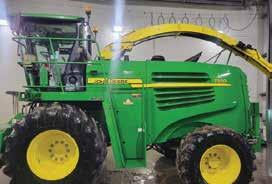




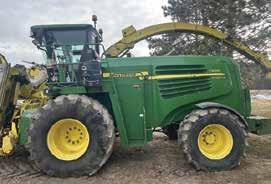





hrs., #560608 ................................ $531,000
8600 2015, Kernel Processor, PRWD, 3153 hrs., 1964 CH hrs., #591484 ....... $152,500
9500 2023, Kernel Processor, PRWD, 158 hrs., 100 CH hrs., #550293 ........... $575,900
JD 9500 2023, Kernel Processor, PRWD, 367 hrs., 210 CH hrs., #586492 ........... $539,900
JD 9600 2022, Kernel Processor, PRWD, 884 hrs., 618 CH hrs., #593717 ...........
9700 2021, Kernel Processor, PRWD, 1146 hrs., 730 CH hrs., #593716 .........
9700
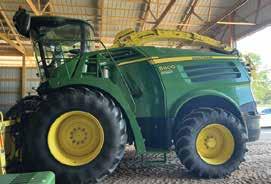




9800 2019, Kernel Processor, PRWD, 1589 hrs., 1200 CH hrs., #585961
9900 2021, Kernel Processor, PRWD, 1222 hrs., 770 CH hrs., #565397 .........
9900 2021, Kernel Processor, PRWD, 2039 hrs., 1518 CH hrs., #585650 ....... $319,900
It appeared everything was falling in place as I checked off my to-do list at a blistering pace. The relief milkers were ready to handle all the cattle chores. Check. Our neighbor boy was eager to come over and feed the calves between his own calf chores. Check. There were no cattle due to calve while we were gone. Check. Emergency numbers were displayed in the barn, just in case. Check.
I switched over to my personal check list. Mark’s dress shirts were pressed. Our formal clothes were in hanging bags, clinging to the edge of the closet door. I had my travel activity bag packed with books to read and notebooks to write down ideas for new adventures. Check. Check. Check.
We had been praying for clear skies and dry roads as we ventured to Madison, Wisconsin, for Michael and Rachel’s wedding at the end of February. You never know for sure what kind of weather you’ll be
dealing with, but it appeared God was answering our prayers. Everything seemed to be falling into place, just like we planned.
Woah, stop the bus. Like we planned? Have you ever heard the story about who’s in control? If you want to make God laugh, just tell him what your plans are. Despite all our best-laid plans, it may not be the direction God had in mind.
I created my checklist to get me through a very busy wedding week. I didn’t want to drop the ball between all our commitments. Our county American Dairy Association had a booth at the Farm Show on Tuesday and Wednesday that week. I worked both days, serving ice cream and laughter to people who stopped by. It is always so much fun talking with the different people who wander by the booth. They always seem glad to talk as you hand them ice cream cups and other dairy items.




With summer heat approaching, maintaining health, production and growth is vital to being profitable. BOVINE ACCELLYTE II is a specialized electrolyte for periods of stress, rehydration and pre-hydration during events such as:
•Heat stress•Calving•Illness
•Shipping/receiving
•Feed changes
Apparently, I wasn’t the only one sharing on those days. I must have picked up a bug of some sort. By Thursday morning, I couldn’t crawl back into bed fast enough after feeding my calves. I felt miserable. I thought I could just sleep it off and would be ready to travel the next day.
Jackson was able to come over and feed calves that evening for me, as I tried to build back my strength. I remember yelling out the front door to his mom to thank her for bringing him over a day early to help. It was 4:30 p.m. and time for Jeopardy. The next thing I remember, it was after 1 a.m., and I was in a hospital room.
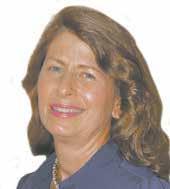
By Natalie Schmitt Columnist
After milking that night, Mark found me unconscious on the kitchen oor between the island and the counter. My left eye was swollen shut, ringed by colors of deep purple and blue. Poor guy was having ashbacks of 20 years earlier when he found me passed out on the bathroom oor. At least he instinctively knew to call for an ambulance this time.
What we have concluded is that I passed out due to a combination of low blood pressure, high fever and dehydration. I also ended up testing positive for COVID. To add insult to injury, the nose piece of my glasses busted my nose on impact. The best news out of all of this: I wasn’t in any pain. At this point, I’m taking all miracles, large and small.
Despite all this bad news, there are still blessings. Becca grew up across the eld from us. She and Katie are best friends. She grew up to be an emergency room nurse at our hospital and was working that night. She guided us through all the hospital stuff and got me settled into a room. She knew Mark was anxious about me and the wedding. In God’s perfect timing, Becca had that weekend off and volunteered to take care of me at home so Mark could attend the wedding.
Everything else just seemed to fall into place. The wedding was perfect. I was able to watch a live stream of the ceremony. The best part is that my feet didn’t hurt because I didn’t have to break in a new pair of shoes. I could relax on the oor with an ice pack on my face and just chill out as the kids made their vows to one another. I did miss a great meal, but I was still able to “dance” with Michael during the mother/son dance as my sister FaceTimed me as we all danced together. There wasn’t a dry eye among us.

BOVINE ACCELLYTE II helps to promote feed and water intake, and therefore, restores electrolyte functions and water retention to prevent losses due to dehydration.




It is strange how all this “new” technology is so commonplace in our lives. We break down in the elds and can FaceTime the repair shop or parts guy to get back up and running. We can pin an exact location for direct fertilizer deliveries without even getting off the tractor. We can always have an “eye” on what our cattle have been up to with their activity monitors. It’s kind of nice how this new way of doing things can give us new opportunities to keep our jobs moving forward and stay connected to those who aren’t so close.
Even with these setbacks in all my planning, I’ll still keep trying to map out my steps. I’ll just try to make sure I check in with the one who has the master plan so I can follow his best-laid plan.
As their four children pursue dairy careers off the family farm, Natalie and Mark Schmitt started an adventure of milking registered Holsteins just because they like good cows on their farm north of Rice, Minnesota.
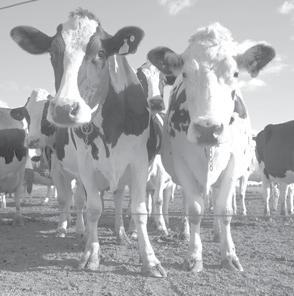

In 2024, the Midwest Dairy Foods Research Center experienced another successful and productive year. We completed and implemented our 2024 strategic plan, actively engaging stakeholders to align our initiatives with our mission: to develop dairy scientists and innovate dairy technologies, ingredients, and products through industrydriven collaborative research, thereby driving regional and global opportunities for Midwest dairy farmers. This mission was accomplished through the collaborative efforts of principal investigators from six member universities, graduate students, industry partners, Midwest Dairy and Dairy Management Inc.
The dairy and food science department at South Dakota State University welcomed new leadership under Dr. Londa Nwadike, department head/professor, David A. Thompson Endowed, with whom we have already established an effective working relationship. At SDSU, Dr. Prafulla Salunke, associate director of MDFRC, has made remarkable progress in expanding his research program and strengthening industry collaborations. He successfully conducted another year of the membrane ltration short course for the dairy industry, attracting 26 industry professionals. Additionally, he partnered with Dr. Maristela Rovai to organize a workshop on avian inuenza, attended by 60 dairy farmers, to address critical concerns for dairy producers.
Under the mentorship of Dr. Maneesha Mohan, ve students earned awards in the products judging competition across various categories, while two students received recognition in the new product development competition. Additionally, a team from the University of Minnesota secured rst place in the new product development competition organized by DMI at the national level. Their innovative creation, Yay-tost, is a creamy Norwegian-style, brown, whey-based cheese spread that is rich in protein, contains 3g of dietary ber and is an excellent source of calcium. Dr. Jayendra Amamcharla coached the team.
The pilot plant facilities, including the Institute for Dairy Ingredient Processing, Davis Dairy Plant at SDSU and The Joseph J. Warthesen Food Processing Center at the University of Minnesota, have continued fostering strong partnerships with regional dairy companies. These facilities remain essential in supporting industry-driven research and development. A signicant milestone in 2024 was the appointment of a

new dairy faculty member at Iowa State University, following the retirement of Dr. Stephanie Clark. This new hire, Dr. Dylan Liu, ensures the continuity of robust dairy processing education and research efforts at ISU. Dr. Liu has expertise in commercial manufacturing processes, food safety, production management and education.
The 2024 spring research planning meeting, hosted by the University of Minnesota at St. Paul, welcomed over 60 representatives from the dairy industry and member universities. Industry partners outlined their research priorities and engaged in meaningful discussions with faculty members, aligning with the newly implemented strategic plan. This engagement led to a record 21 preproposals — three more than the previous year — reecting a growing interest in research initiatives. Of these, 15 were invited to present at the annual meeting in Minnesota. Following rigorous evaluation, the advisory committee approved six new projects, bringing the total number of ongoing MDFRC-funded research projects to 20.
Lastly, six MDFRC students graduated in 2024 and successfully transitioned into the dairy and food industry, underscoring the center’s role in workforce development. Furthermore, our research impact continues to grow, as evidenced by the publication of 40 peer-reviewed articles in international journals.
I would like to extend my heartfelt thanks to all the individuals and organizations who continue to support MDFRC, especially dairy farmers whose unwavering commitment and collaboration play a vital role in our successes and the advancement of dairy science and innovation. Your support enables us to engage in meaningful research, allowing us to address the challenges faced by dairy farmers and to explore new opportunities. Together, we are fostering a vibrant community of dairy scientists and industry professionals, dedicated to pushing the boundaries of what is possible in dairy technologies and products. Thank you for being an integral part of our journey and for contributing to the MDFRC’s growth and success. I look forward to continuing this important work together.




